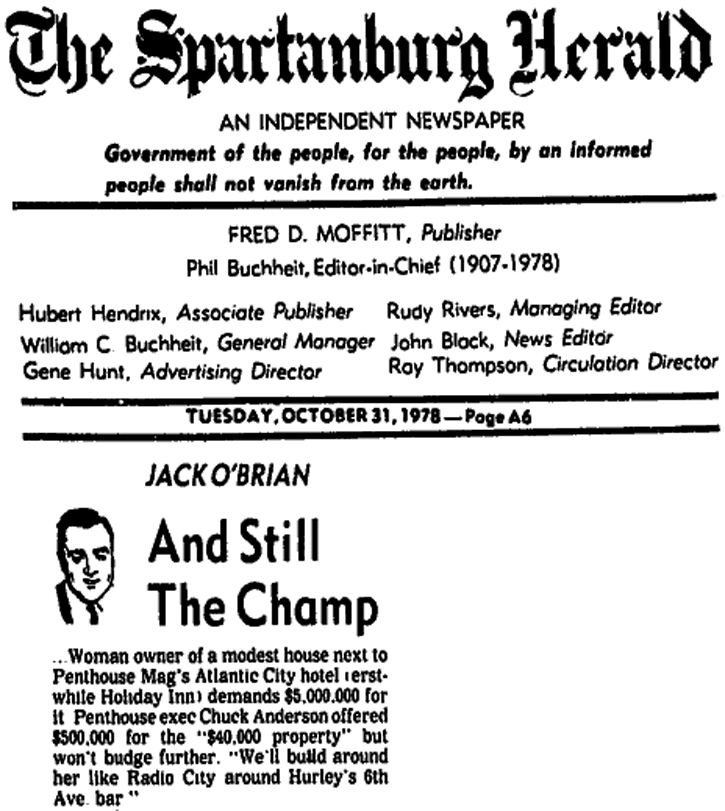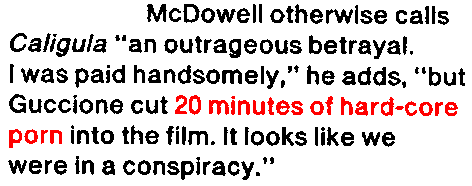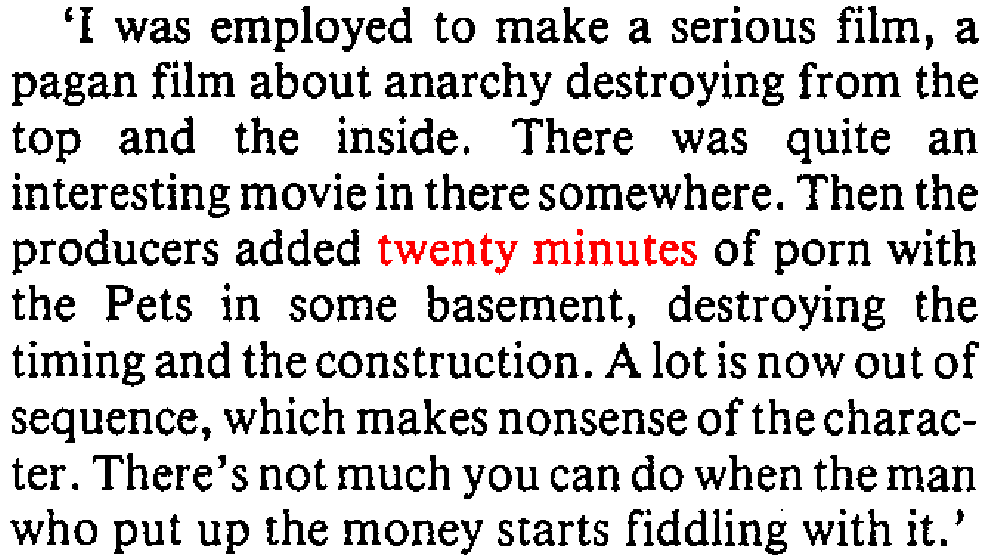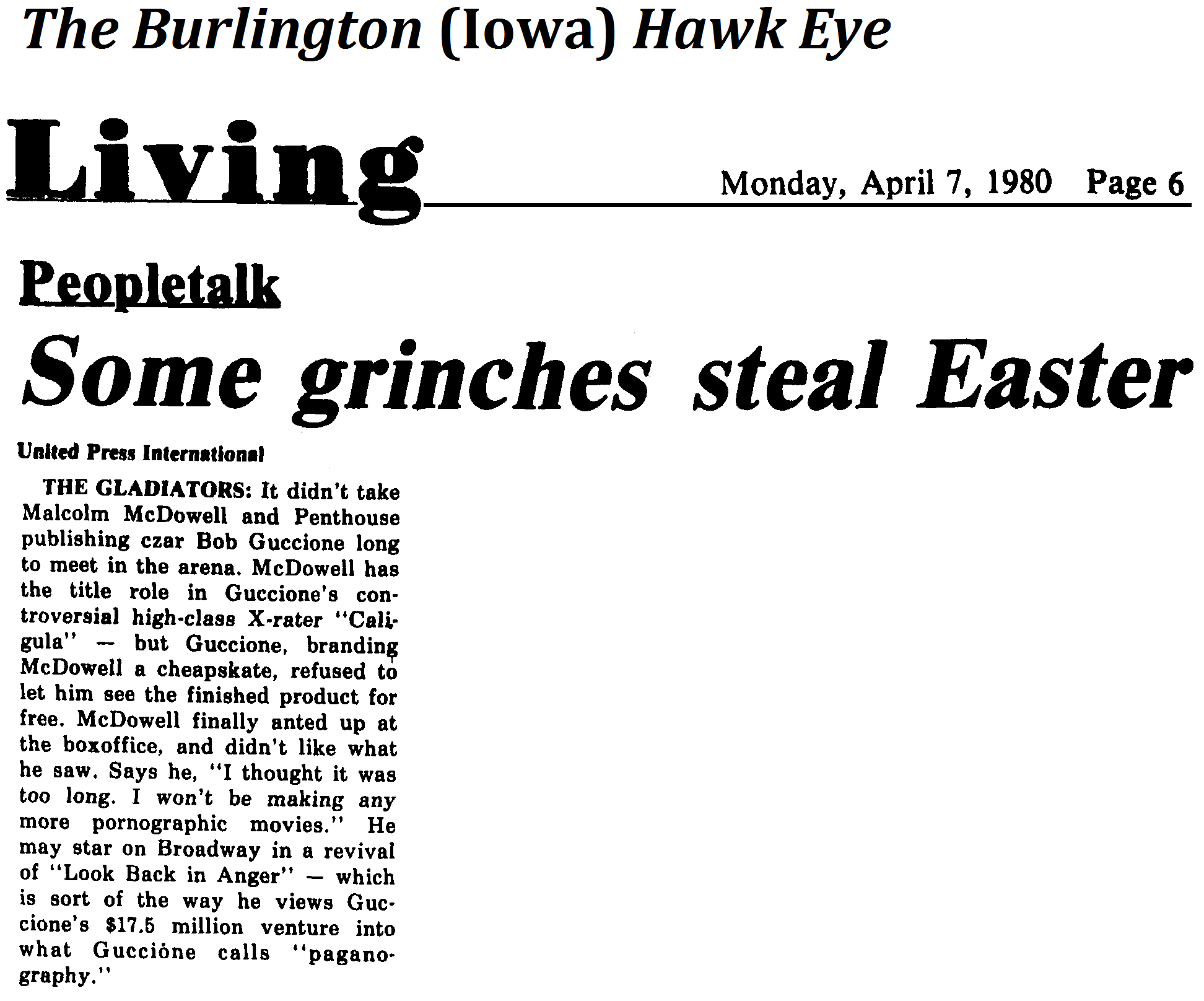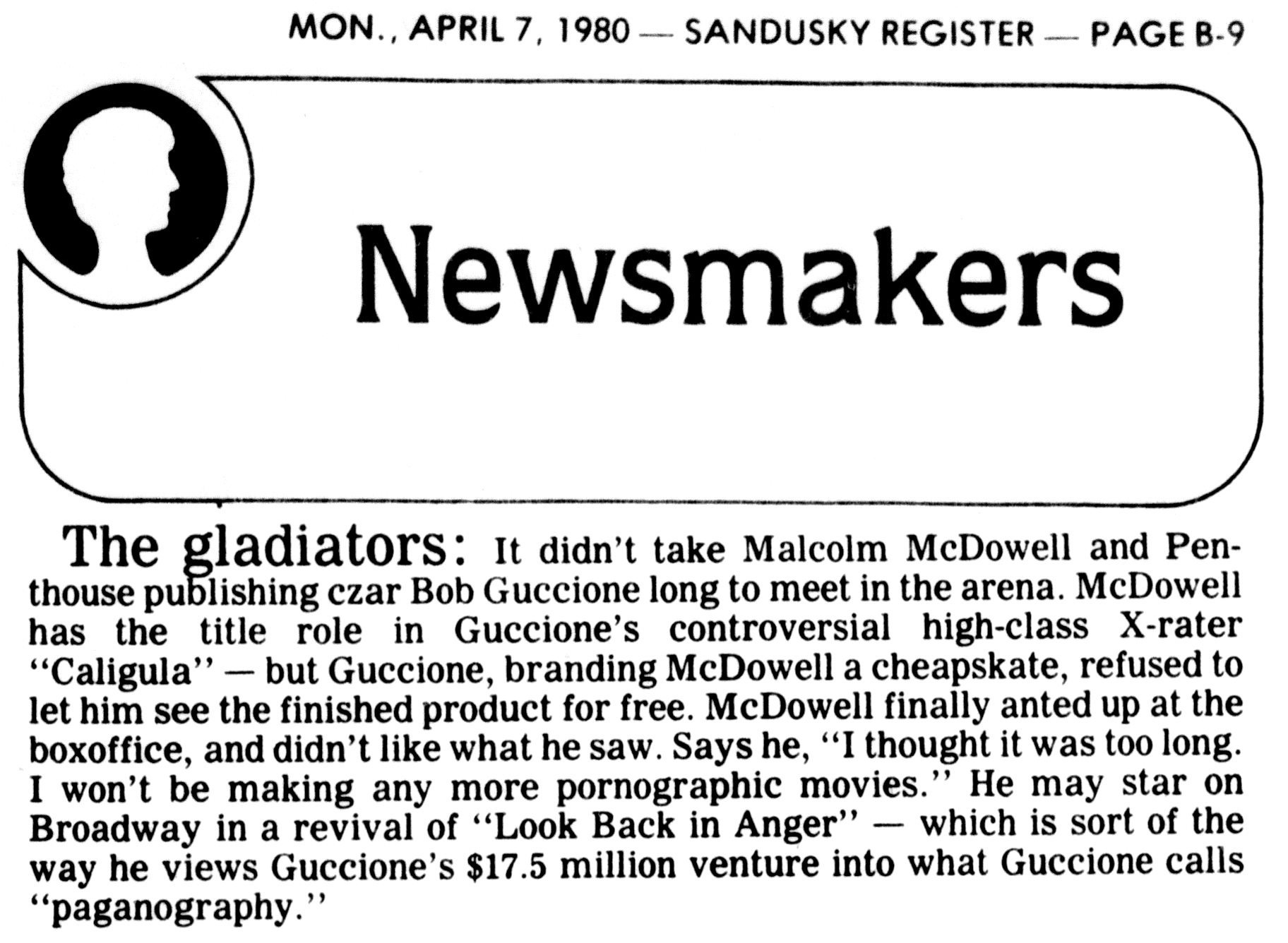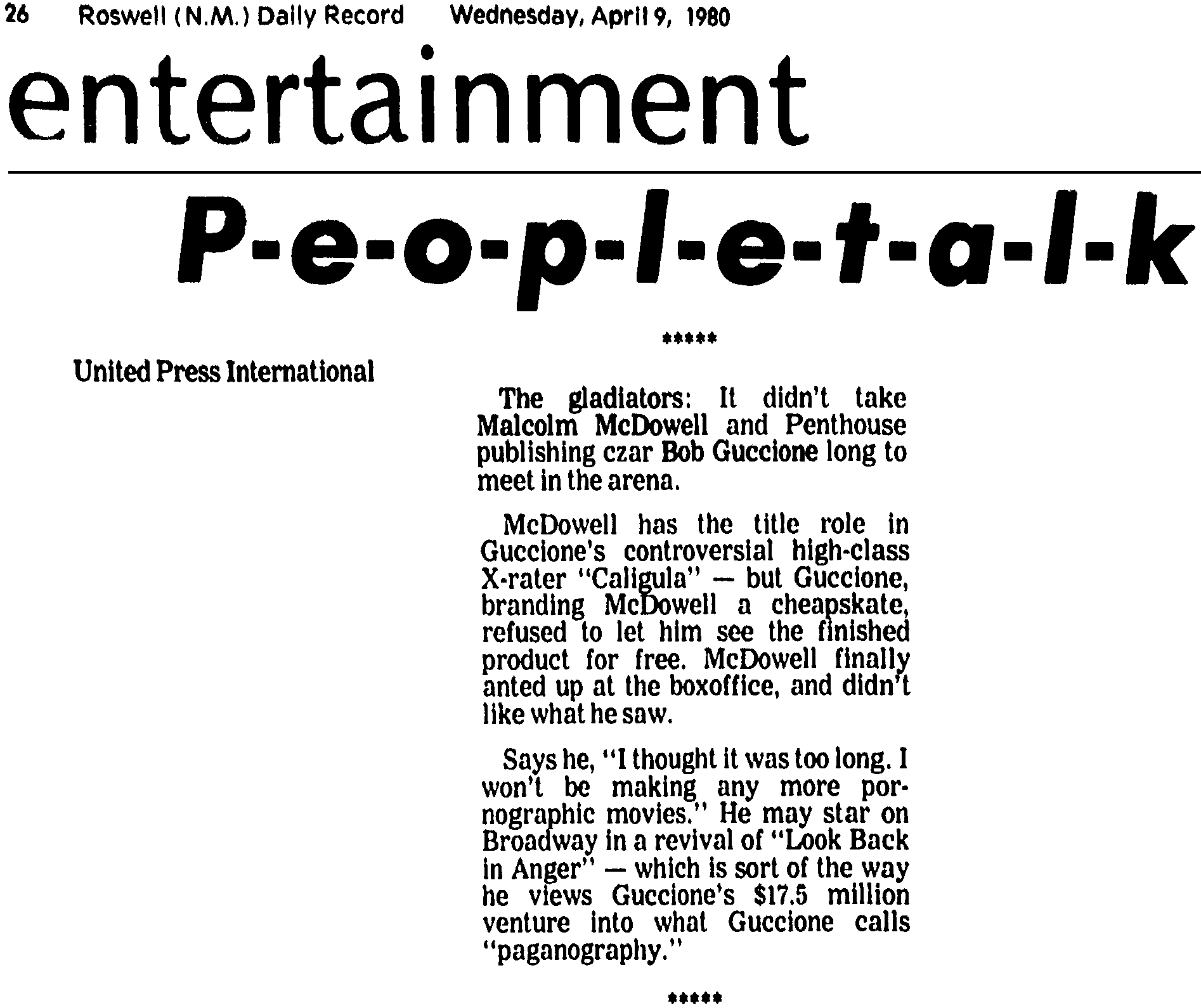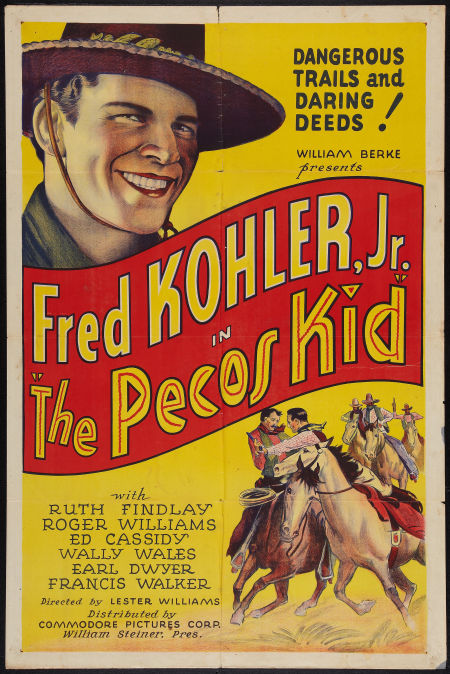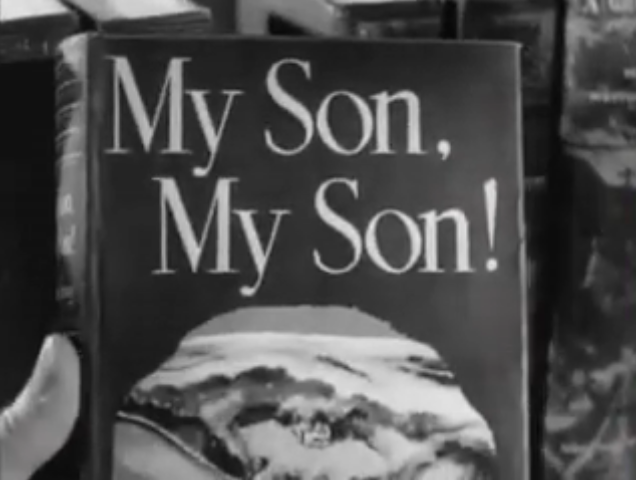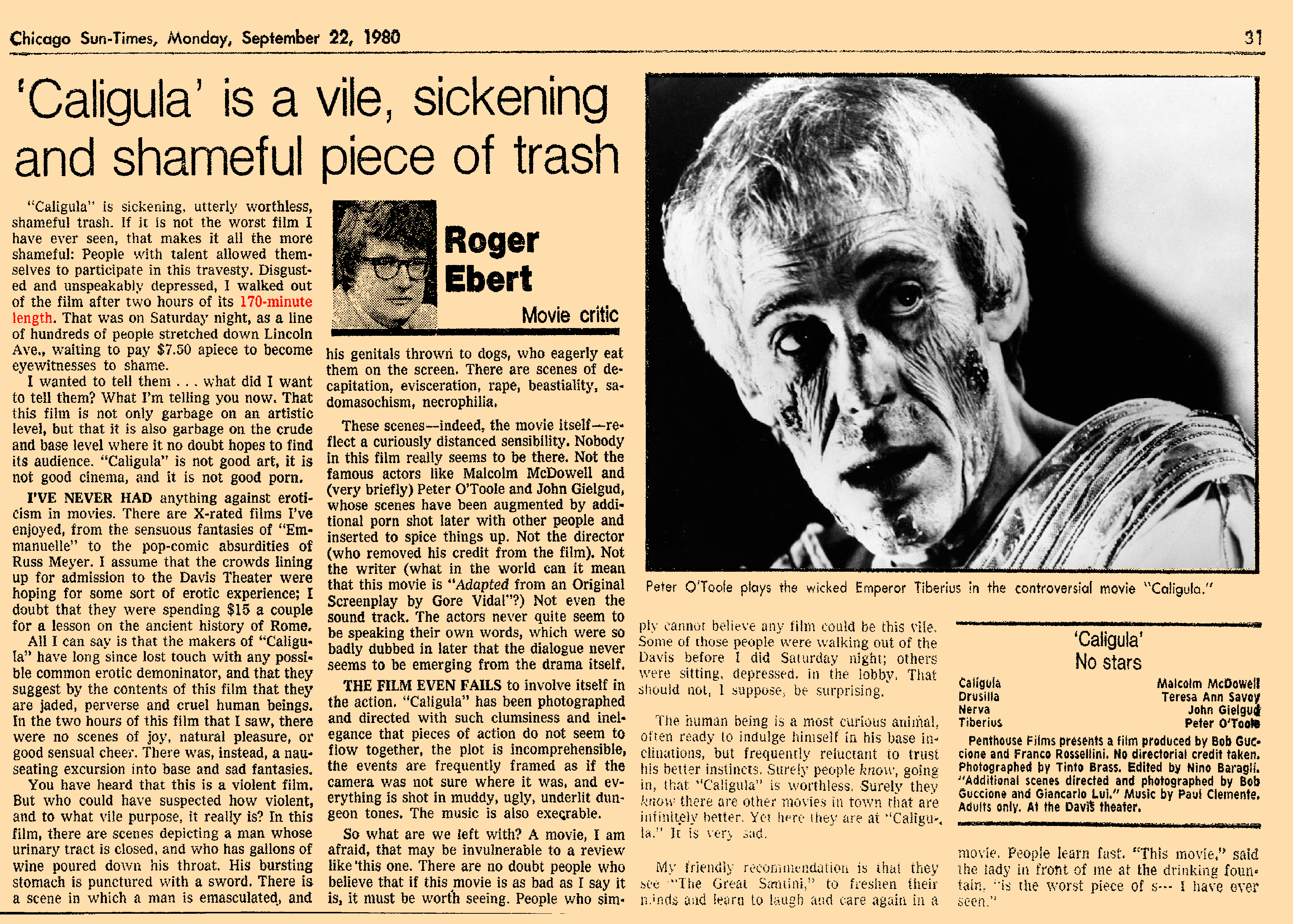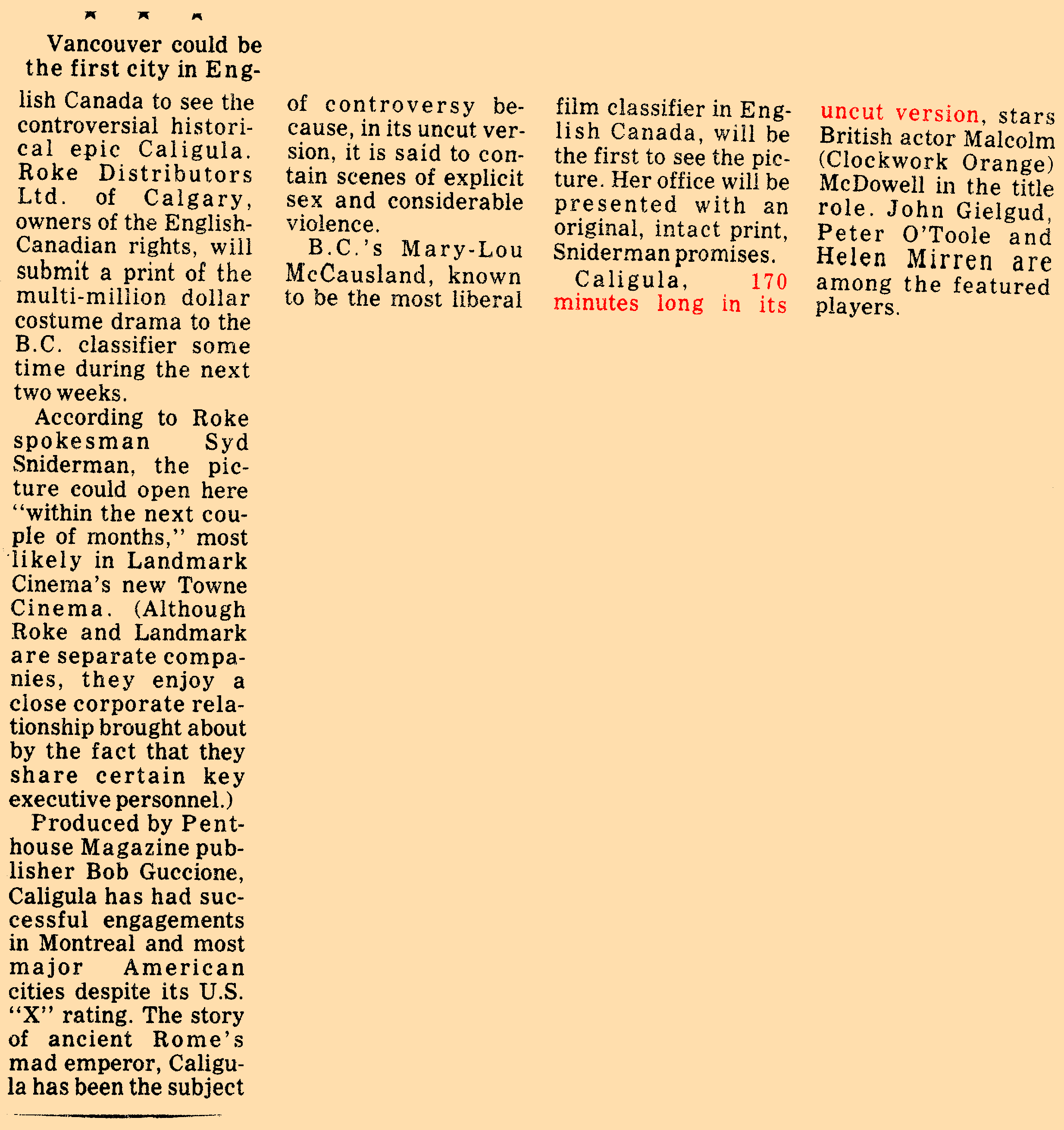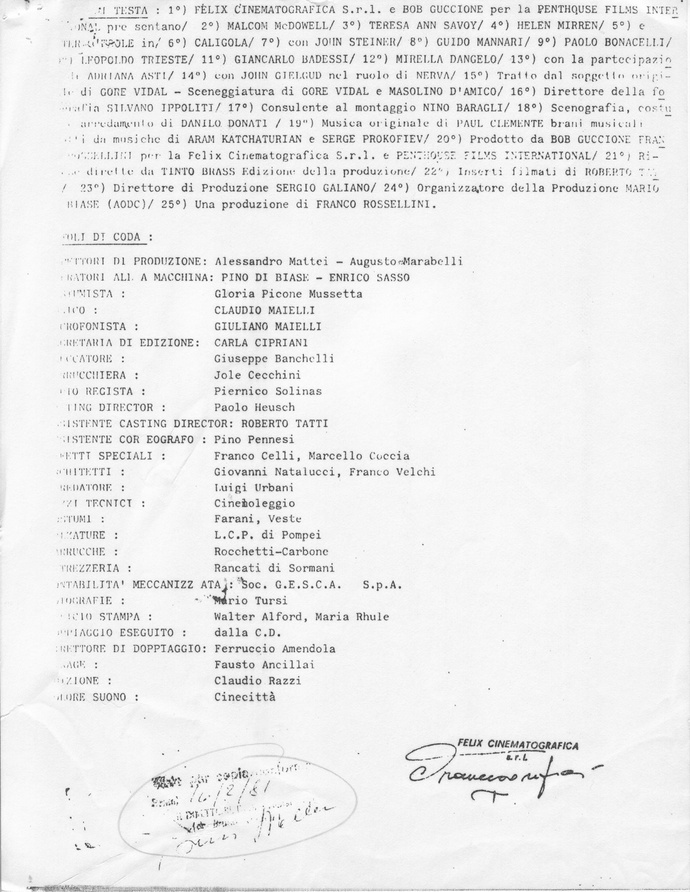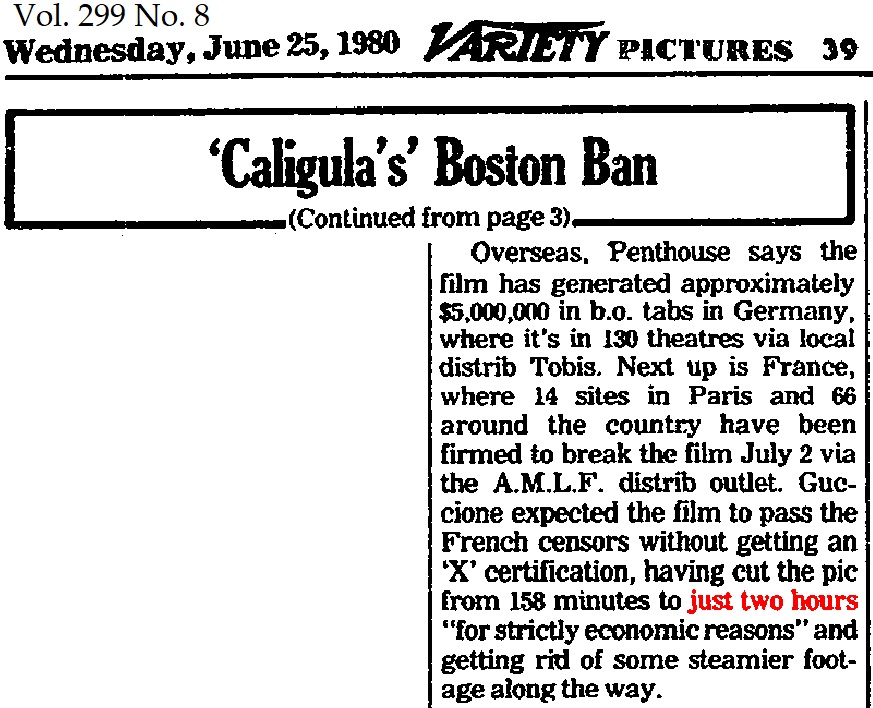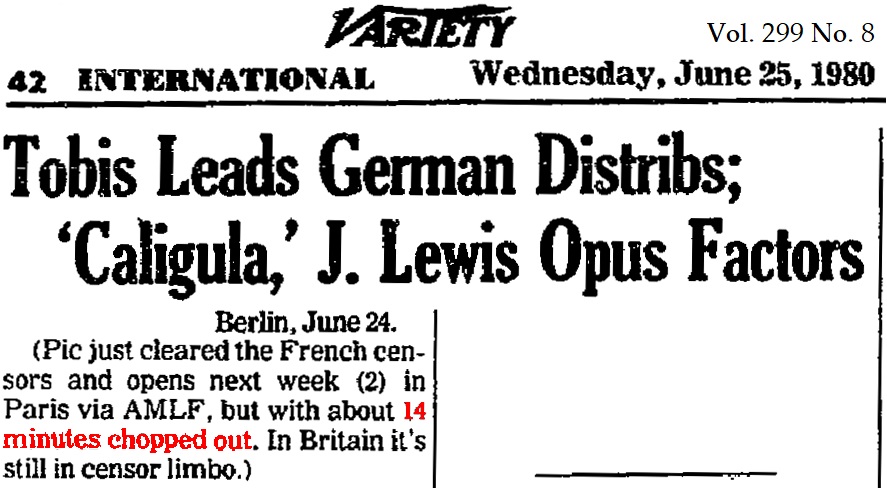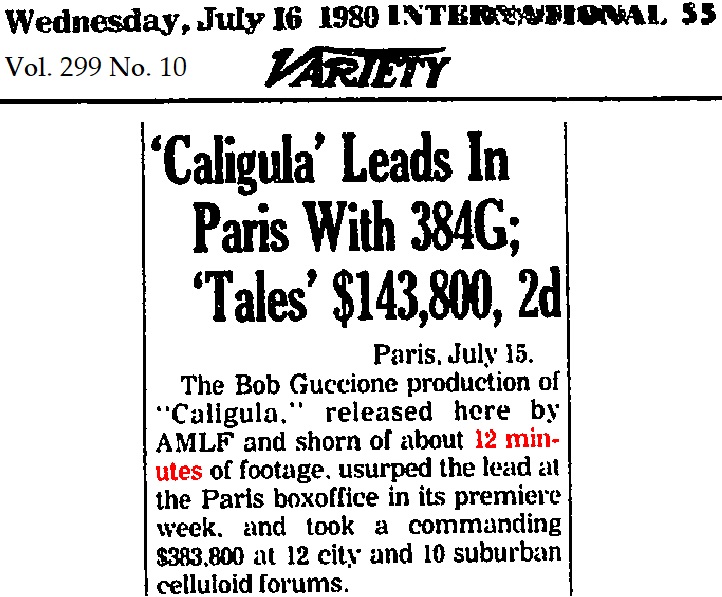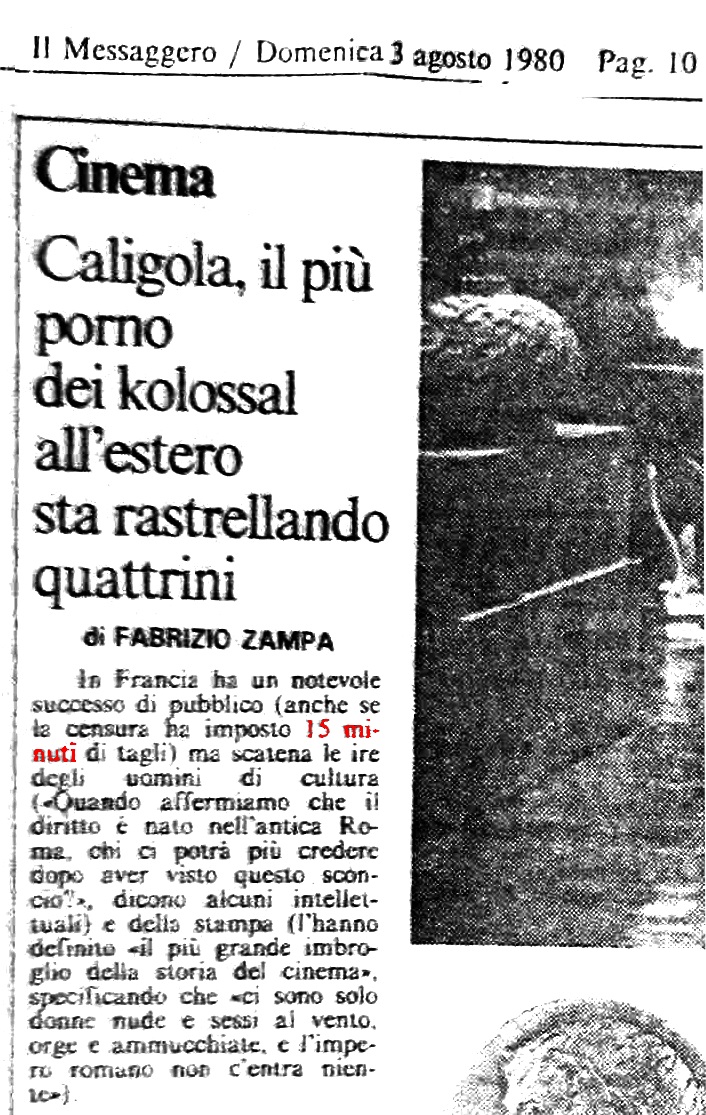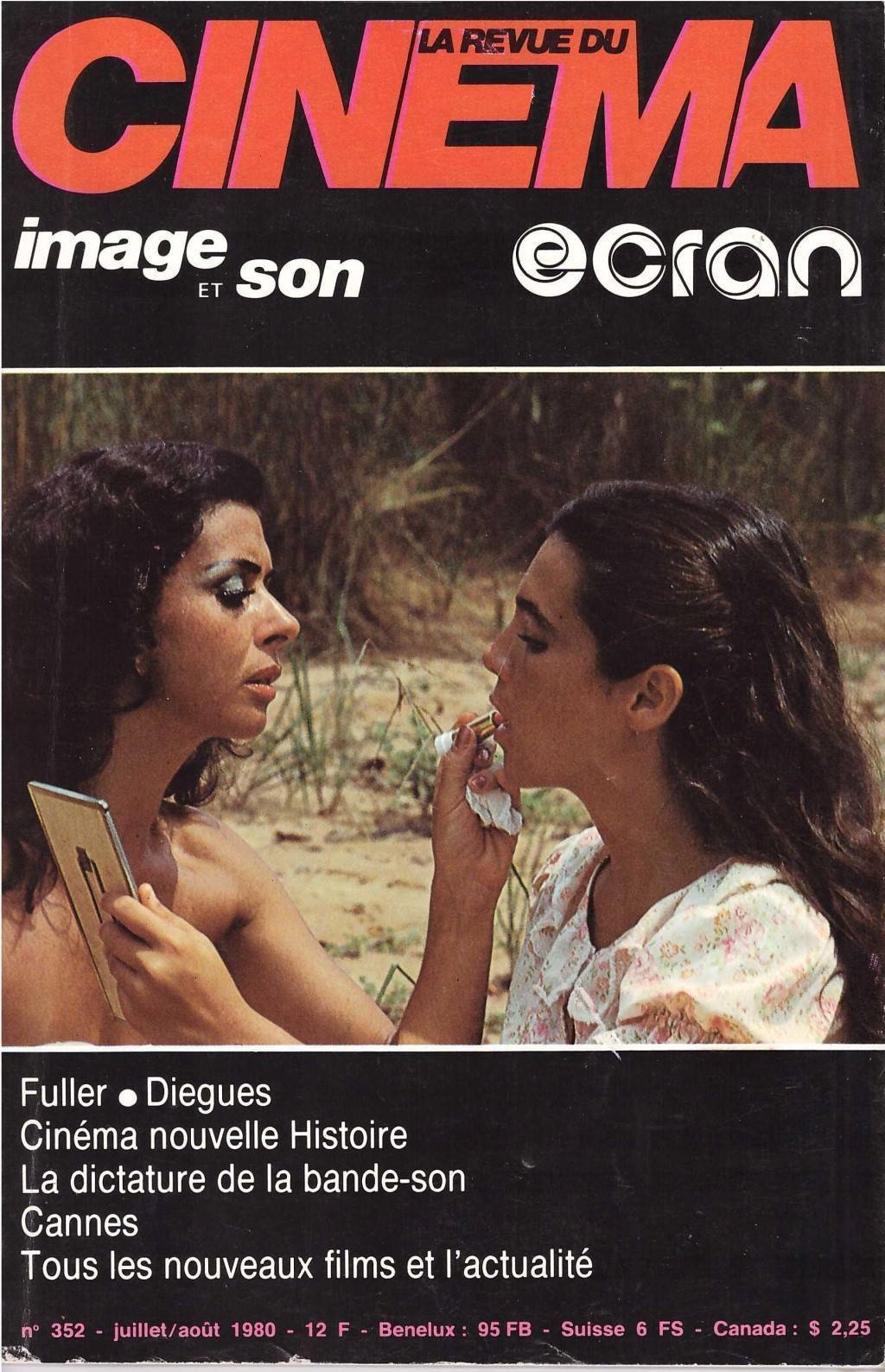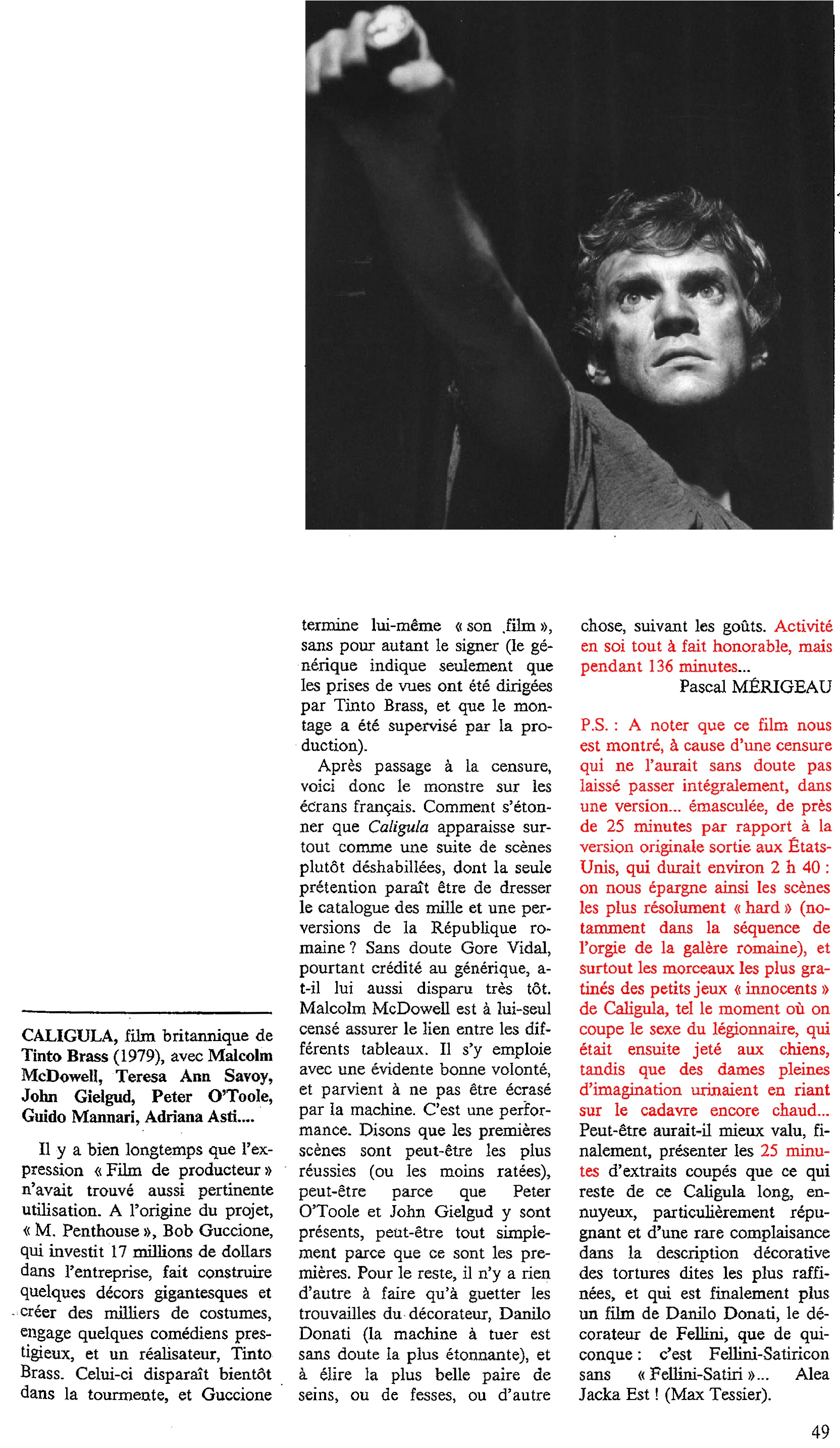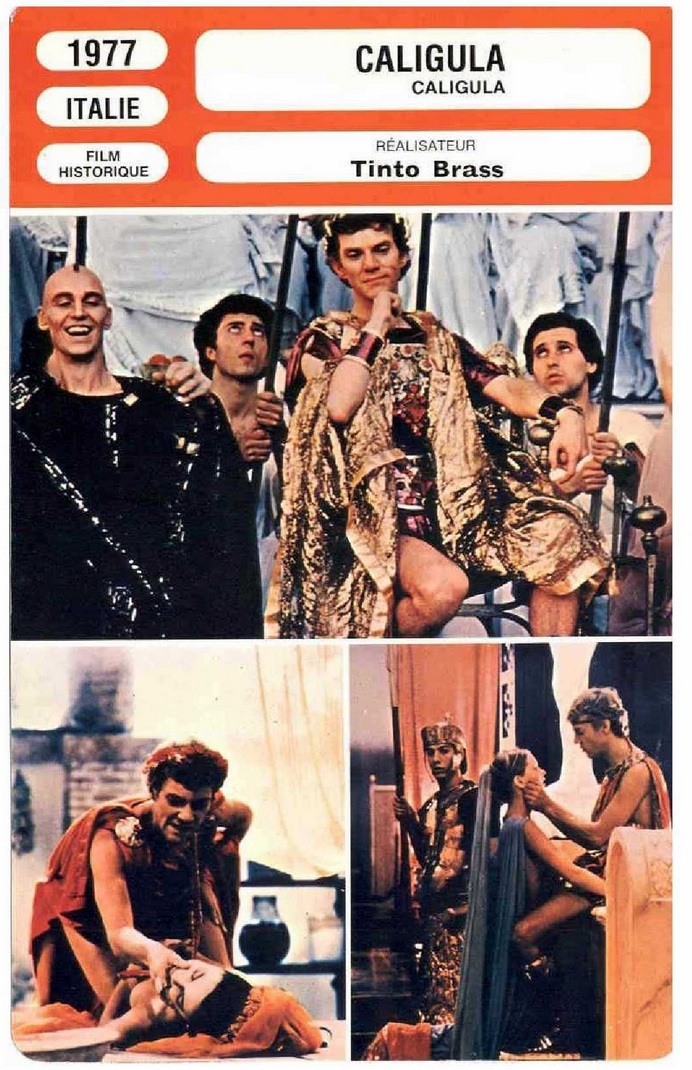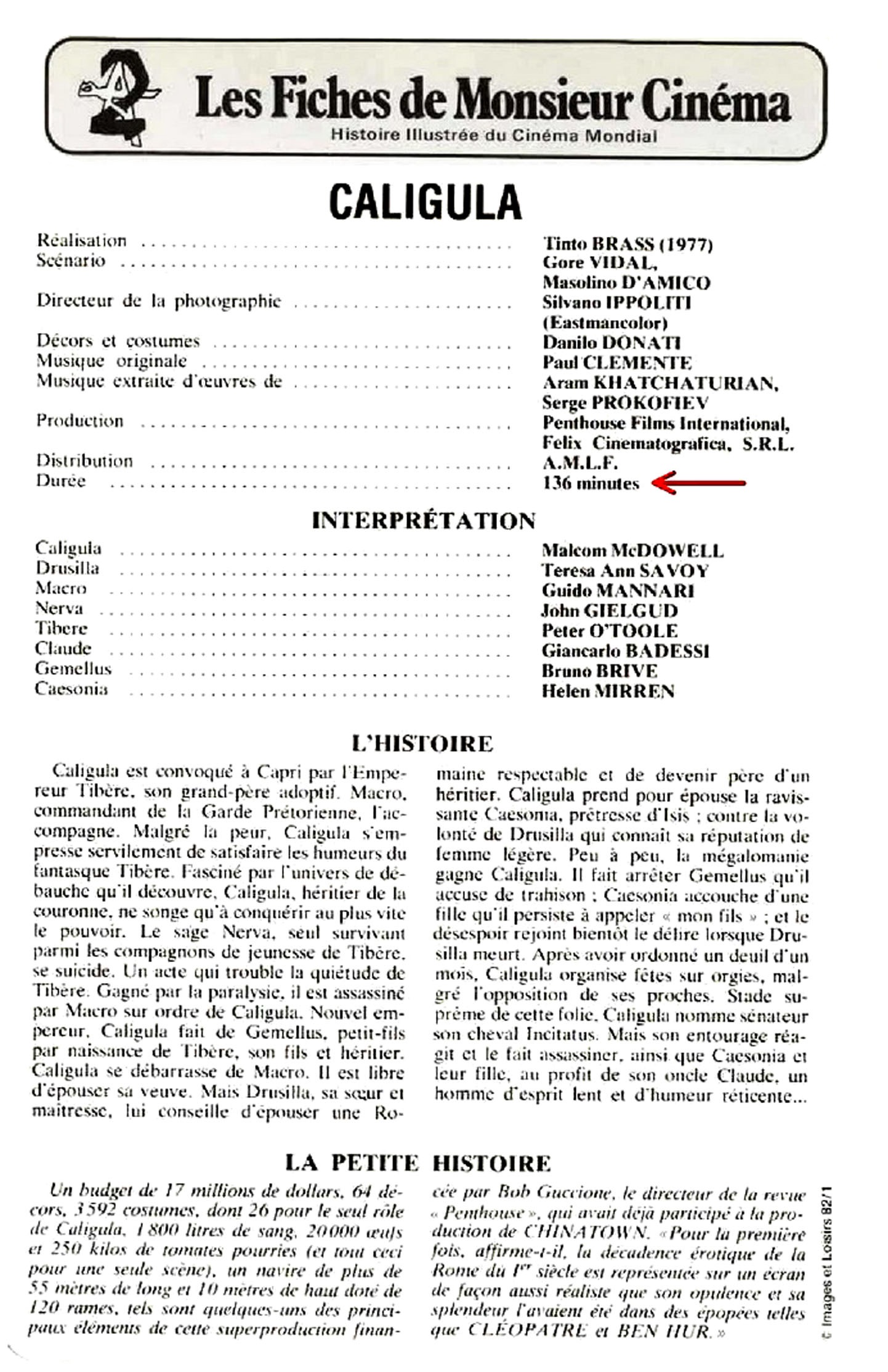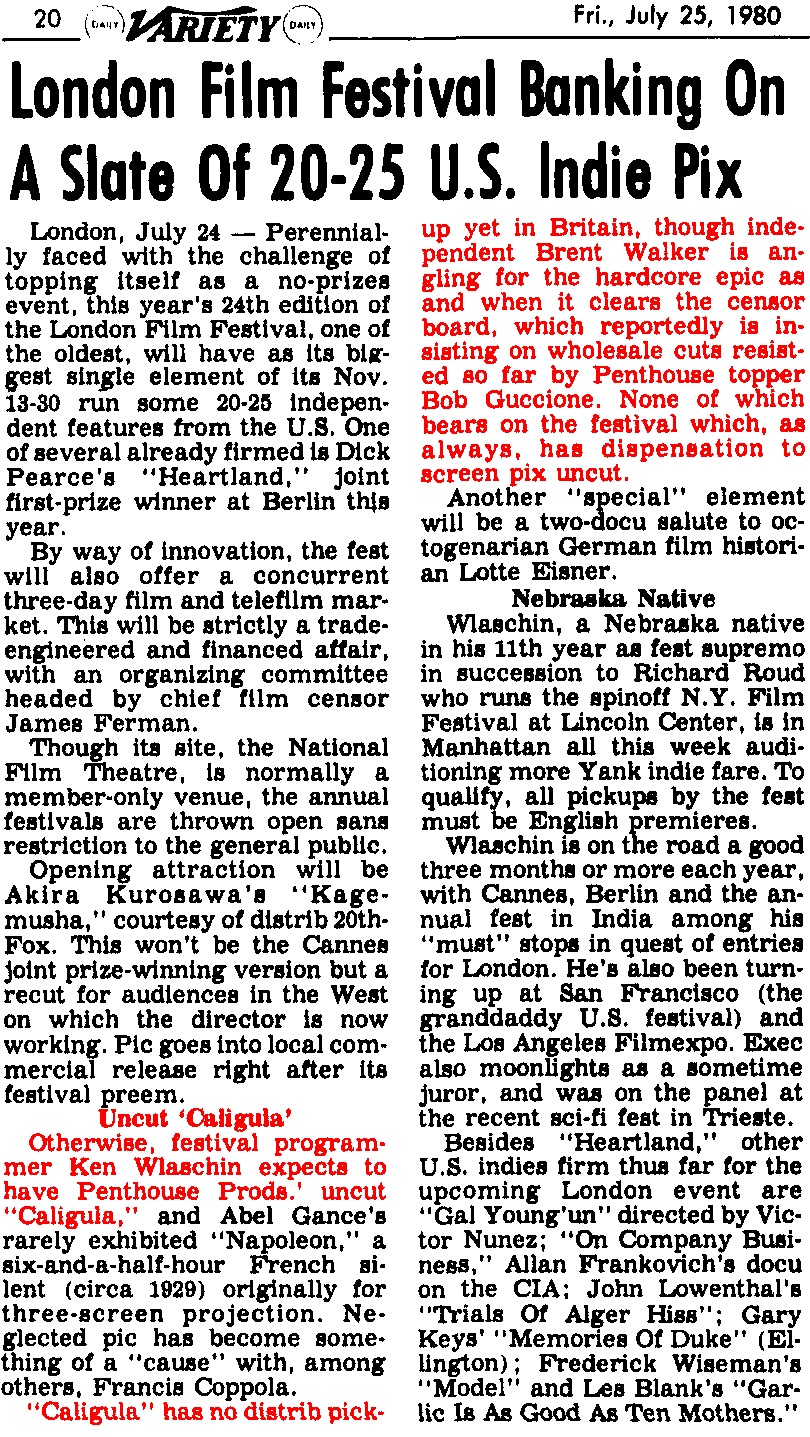|
So now we know precisely how many private screenings there were,
from other sources we know that one screening (probably the second) was on the evening of 11 May 1979
and another (surely the third) was on 22 May 1979,
but that leaves one mystery screening, date unknown, though most likely 10 May 1979.
We do not know the name or address of the screening room.
A few months later, Hank Werba,
in the weekly edition of Variety, said something even more enticing:

Of course, “Werb” did not see the version presented Cannes.
Nobody from Variety saw it at Cannes or was permitted to see it at Cannes.
By the end of 1978 Caligula was pretty much in the form in which we now have it, about 156 minutes.
So what’s all this about a 210-minute version screened half a year later?
A claim of 210 minutes seems a bit extreme.
Were, perhaps, the numerous deleted scenes,
many of whose publicity stills were published in the May 1980 Penthouse and elsewhere,
put back into the print screened at Cannes?
That would seem to be a reasonable assumption, yet that is certainly NOT what happened.
Nonetheless, this unsubstantiated passing reference has gone into film history,
and “sources” from Ultimate Porno
to countless official listings matter-of-factly state that the print at Cannes was 210 minutes.
Other online sources mangled things and stated that the 210-minute version was actually released.
(I think those pages have all been taken down.)
How these stories grow!
In a desire to leave no stone unturned, back in about 1985 or 1986 I tried my luck.
I called Penthouse International and asked if I could get permission to view the 210-minute version.
The fellow who took my call (I wish I could remember his name) went silent for a moment, and then sounded totally confused.
“What 210-minute version?”
Was I perhaps referring to a rough cut?
No, I said, I was referring to the version shown at Cannes in May 1979.
He then sounded even more confused.
But, he explained, the version shown there was exactly the same as the version released in the US in February 1980,
which had been prepared and completed long before May 1979.
When I told him that Variety reported otherwise, he seemed to figure out what went wrong, and attributed the mistaken running time to a typo.
That would seem to make perfect sense.
Someone means to type “2 ½ hours” but mistakenly types “3 ½ hours” instead — et voilà,
history is invented.
In any case, from that day until 3 April 2003,
I dismissed claims of a 210-minute version.
But then I discovered Noel Bailey’s review of the film on the
Internet Movie Database,
in which he claims to have seen it.
Take a look:
|
Art or obscenity? Very much in the eye of the beholder!,
2 November 2002
When discussing CALIGULA...
it becomes necessary to distinguish
WHICH version you are referring to.
Personally I have had the (mis)fortune
to see all three and they vary
colossally—trust me! The original
Penthouse release which has been screened
at mostly underground art houses runs for
over 210 minutes and contains scenes that
would pale the most ardent voyeur or
paedophilic raincoater! Full-on rape with
full-blown (poor choice of words, I realise)
penetration, sodomy, erections every which
way and total hard-core sexual perversion.
Violence you just wouldn’t credit to
being filmable let alone able to be released
etc etc. I really don’t feel inclined
to “review” this particular
monstrosity. Just take it from me, it
projects sick filmmaking to
never-again-to-be-approached
stomach-churning levels....
|
Certain that he was mistaken, I wrote to him and he replied as follows:
|
Thanks
for your email. Nothing I
have ever written for the IMDb has attracted
the worldwide feedback I have had from
CALIGULA.... SIGNS came close but I have
probably had 100-plus people at their
wits’ end LOOKING for this elusive
version—some for 20 years—contact
me in the last few months.
Yeah,
your Penthouse contact
is either wrong or lying because I have
seen the 210-minute version TWICE. The
first time was late in ’79 at an
underground “dive” in London...
the kind of place you don’t ask the
age of the girls sitting beside you. The
other time was in Sydney at a private
screening of a friend of a friend (who
unfortunately died himself many years ago).
As I recall, the print had been illegally
pirated from the UK (probably the same one
I saw the previous year)... there must
obviously BE others out there!
Let me just tell you that
the 156-minute version by comparison to
the “uncut” monstrosity is little
worse than THE LION KING. What is contained
in those “missing 54 minutes”
beggars belief. Full-on, in-your-face
sexual intercourse, sodomy, graphic rape,
visceral violence... you name it... all
lovingly filmed from, at times, just
centimetres from the lens. As I recall,
even scenes of way-underage girls doing
stuff I’m sure their moms hadn’t
taught them. (Bear in mind I can’t
say for a fact that the
girls I saw were underage—I have a
16-year-old daughter myself that in school
uniform you would swear was 12/13... if
that!—and with judicious make-up you
can weave all kinds of magic.) What I SAW
could never have gained theatrical release...
my life has not been enriched by seeing
it (the second time I was well into the
Jack Daniels and ice!!!). Believe me, it
is NOT something you would want to take
your girlfriend, daughter or wife
to see.
But yeah... it exists!
Obviously you have made the
study, investigation, analysis and
crucifixion of CALIGULA a life’s
work... the thing deserves no less!
Noel Bailey
|
 Well, to put it mildly, I was flabbergasted!
If this report is true, then the print must have been made by some employee
of the lab that had performed the negative cutting and was currently holding that edited negative.
But what lab was that? According to all my research, that lab was, I thought,
GTC-CTM Laboratories
(1, quai Gabriel-Péri, 94340 Joinville-le-Pont;
president: J.G. Noel; executive director: Michel Kaganski; contact: Jimmy De Brabant).
Yet I did not realize that once the neg was cut, it was transported to New York City.
After some strange adventures it ended up at
Guffanti Film Laboratories in NYC.
So was it GTC-CTM or Guffanti that would have worked on a padded edition?
The answer is easy: It would have been GTC-CTM, which still retained outtakes and trims.
Guffanti received only the edited camera neg and the master sound tapes
after the rumored Cannes screening of a lengthier edition.
What’s more, I have it on good authority that Guffanti had materials only for a single version,
namely the standard 156-minute release edition.
Well, to put it mildly, I was flabbergasted!
If this report is true, then the print must have been made by some employee
of the lab that had performed the negative cutting and was currently holding that edited negative.
But what lab was that? According to all my research, that lab was, I thought,
GTC-CTM Laboratories
(1, quai Gabriel-Péri, 94340 Joinville-le-Pont;
president: J.G. Noel; executive director: Michel Kaganski; contact: Jimmy De Brabant).
Yet I did not realize that once the neg was cut, it was transported to New York City.
After some strange adventures it ended up at
Guffanti Film Laboratories in NYC.
So was it GTC-CTM or Guffanti that would have worked on a padded edition?
The answer is easy: It would have been GTC-CTM, which still retained outtakes and trims.
Guffanti received only the edited camera neg and the master sound tapes
after the rumored Cannes screening of a lengthier edition.
What’s more, I have it on good authority that Guffanti had materials only for a single version,
namely the standard 156-minute release edition.
|
SIDEBAR: Please correct me if I’m wrong, but I think this is the GTC-CTM history:
• |
|
• |
|
• |
|
• |
In 1958 Gaumont and Pathé formed a nonstandard-format joint venture with LTC. (I assume this is the present-day Laboratoire des Techniques Cinématographiques?) thus giving the lab a new name, GTC. |
• |
In 1970 CTM adopted the official name Laboratoires Cinématographiques CTM. |
• |
In 1979 GTC merged with CTM to become GTC-CTM. |
• |
CTM retained its acronym but changed its name: Compagnie de Travaux Mécaniques. (Or are these two different CTM companies?) |
• |
|
• |
|
• |
|
|

The Guffanti story is one that I may never learn.
It was founded in 1929
and
went out of business in 1996 or thereabouts,
and I don’t know how to trace anyone who worked there.
Porn director Shaun Costello, effectively employed by the Gambino family,
posted a collection of jaw-dropping stories at the defunct
rec.arts.movies.erotica newsgroup. Here’s what he had to say about Guffanti:
“After a few bad experiences
we switched to Guffanti Film Labs, in the Film Center Building at 630 Ninth
Avenue, where we had our offices and editing room. Paul Guffanti Jr. ran the
business for his semi-retired father. Guffanti was the last lab in NYC to
process black-and-white film stock, and Woody Allen had his lab work done
there in the seventies. But porn was Paul Guffanti’s cash cow, and he was
happy indeed to put the wad of bills the porno producers gave him on a
regular basis into his pocket, providing no receipt, and having made no
record of the transaction.”
Costello has more stories on his blog.
Now, Paul Guffanti (Sr.? Jr.?) had worked
on When Comedy Was King (1960) and Days of Thrills and Laughter (1961) among many other above-ground projects,
and that proves that Guffanti was a perfectly legit operation.
As for the Gambinos being customers, well, we cannot and must not make any leap. Guffanti was not at fault.
Penthouse’s involvement was similarly casual.
When Penthouse could not reach an agreement with a more famous laboratory,
a temp worker shopped around for a lab that was more amenable and found Guffanti. It was as innocent as that.
Nonetheless, I cannot help but ponder:
Guffanti was the Gambino family’s preferred laboratory
and later became Penthouse’s preferred lab as well.
That would look like the purest coincidence, but there was a complicating factor:
the presence of Chuck Anderson, Jr., the longtime greeter and assistant manager at the 21 Club,
who in 1977 became an integral part of the Penthouse staff and served as Bob Guccione’s right-hand man,
as we learn from a
response to a FOIA request (which is a must-read). Further:
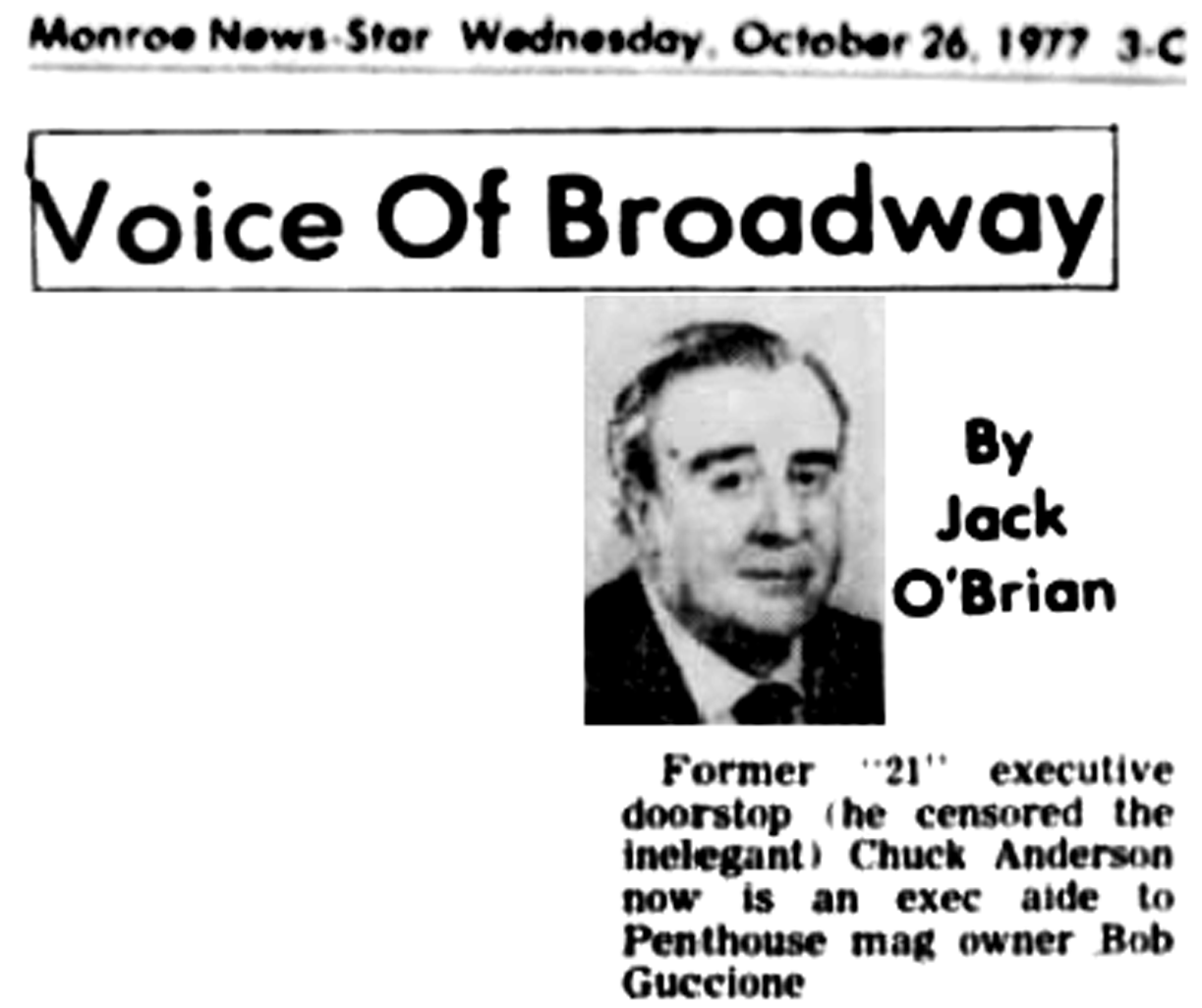
Anderson and Guccione even occasionally shared a penthouse apartment together (40 Central Park South).
I doubt that any folks at Penthouse HQ knew about that arrangement.
Everybody knew that Bob would occasionally disappear and become incommunicado, yes, but nobody ever found out where he had been or what he had been doing.
Does this answer at least part of the reason why? I wish I knew.
Despite this close business relationship, Anderson was not listed on the Penthouse masthead until about 1983.
For what it’s worth, Anderson had the peculiar habit of wearing unbuttoned shirts revealing massive amounts of gold necklaces on his chest.
Why does that remind me of something?
Anderson’s first cousin was Anthony “Nino” Gaggi,
caporegime of the Gambino crime family.
Dismiss that as coincidence or irrelevant, if you choose.
I choose not to dismiss it.
Anderson’s job title, beginning in circa January 1983, was “National Field Sales Manager” and, a little later,
“Director, Eastern Regional Sales” for Penthouse and Omni and maybe some other Guccione magazines too.
An FBI informant explained what Anderson’s duties entailed:
“ANDERSON sets up broads, associated with Penthouse magazine, with rich businessmen.”
(An FBI agent summarized: “It appears that ANDERSON is running a high-class call-girl operation.”)
In the meantime, Gaggi was manœuvering to obtain “the limousine contract for the Penthouse Casino.”
When events did not go as planned, Anderson was shot during a “robbery” (nothing was stolen) at his Truffles Restaurant on 6 September 1983
and died as a result of his wounds three months later, on 18 December.
Nonetheless, he continued for a while to be listed on the Guccione mastheads as “Sales Director, West Region.”
“The source said he believed in the past that NINO GAGGI was unhappy with ANDERSON
due to ANDERSON’s well-publicized contacts with the FBI, CIA, and Washington, D.C.”
Am I making a mountain out of a molehill?
Or am I making a molehill out of a mountain?
Might Penthouse have chosen Guffanti based on Anderson’s recommendation? Maybe, but doubtful.
If so, did that have any deeper significance? I really doubt it.
But do you understand why I’m so curious about all this?
FURTHER READING:
• Leonard Buder, “Robber Wounds a Restaurateur on the East Side,” The New York Times, Wednesday, 7 September 1983, p. B4.
• Leonard Buder, “Crime Update: Motive a Mystery in Killing on the East Side,” The New York Times, Sunday, 2 October 1983, p. 42.
• (AP wire story), “Charles Anderson, 63, Dies; Formerly Greeter at ‘21’ Club,” The New York Times, Tuesday, 20 December 1983, p. B8.
|
On Thursday, 17 April 2003, I wrote back to Noel, asking for particulars on the when’s and where’s and how’s,
and especially about how the exhibitors announced it without getting caught, and how they got everyone to keep quiet about it.
He replied:
|
The screening in London was at some
late-night club not too far off Leicester
Square as I recall... might have been
along Shaftsbury Avenue. Never knew what
it was called... smoky, seedy and for
the most part mega-dingy. Late late
underground London Town club life
doesn’t usually come with
full-addressed memory hehe! Was there at
the invite of an acquaintance simply to
“see something pretty hot.”
The title CALIGULA was not mentioned
beforehand. HAD it been I might have
paid more attention as I was aware of
problems surrounding the film’s
production even then! It was shown in a
small private room just off the main
bar... perhaps 20 or 30 of us were there
in varying stages of inebriation. There
were no attempts at secrecy... just
looked to me like a private porn show in
the offing, “Debbie Does Tottenham
Court Road” or whatever! As it turned
out that’s basically what it
was... simply a
17-million-dollar work-out! Presumably
it was on 35mm film as it was just fed
reel to reel through a standard projector
and using a portable screen would barely
have been two metres square. Bear in
mind that particular night I, and as far
as I know no one there, had any reason to
believe that what was being screened was
pirated, contentious (well, beyond its
content, anyway) or in any shape or form
clandestine. It ran for
well over three hours...
that I DO recall! I saw no
one approached to keep their silence on
the matter! I certainly wasn’t.
It was only when I actually
saw the film at a theater in Sydney the
following year that I realised what had
been cut out (and I think THAT screening
barely topped 120 mins).... I acquired
the 155-plus-minute version on Beta tape
5 years later.
Now... I DO have a problem
unveiling details of the Sydney screening
for the simple reason that it was at the
home of a well-known (at that time at
least) Sydney television personality...
one I had known for well over fifteen
years in 1980. Being in the television
and entertainment industry... John (not
his real name) had “connections”
in the business obviously and he invited
me to see this “uncut version,”
quite unaware that I had already seen it.
At the time, I didn’t even know it
WAS the same “cut,” but on
viewing it, this proved to be the case.
He DID confirm that it had been shipped
from the UK and that there were
“those who would seek to refute its
existence.” It was screened at his
home in Sydney’s exclusive Eastern
suburbs. There were less than 10 people
there that day!
|
So the claim of “over 210 minutes” is here modified to “well over three hours”
with the proviso that the person making the claim was inebriated both times he saw it.
What the “visceral violence... [v]iolence you just wouldn’t credit to being filmable”
might have been remains a mystery.
Tinto shot only two violent moments that were deleted from the final film,
and we can see one of those two moments in the supplements to the deluxe “Imperial Edition” DVD box sets.
That, of course, was the sacrifice of the priest rather than the bull.
The other alleged — alleged — moment is one you’ve never heard of, during the Victory Banquet, held in honor of Caligula’s battle against Britain.
Caligula plays a Simple Simon Says game, only a meaningless fragment of which survives in the final film.
CALIGULA
Almighty Cæsar says, take a grape and catch it in your mouth.
Fail — fail — fail.
Longinus, keep a note of all those who fail.
LONGINUS
Yes, Divine Cæsar.
CALIGULA
Almighty Cæsar says stand.
Almighty Cæsar says get down.
Almighty Cæsar says turn right.
Fail — fail — fail.
Almighty Cæsar says run.
Almighty Cæsar says stop!
Almighty Cæsar says hop!
Almighty Cæsar says stop.
Almighty Cæsar says crawl.
Crawl! Crawl! Crawl! You bastards. I hate them!
Almighty Cæsar says stop!
Almighty Cæsar says, to balance the State budget, we shall confiscate the entire estate of all those who have failed.
Read out your list, Longinus.
LONGINUS
Senators Galba, Aponius, Marcellus, Antonius, Cassius, Guccionius, Petonius annis,
Felixius, Walteralfordonius, Tintus, Silvamanonius, Francannus, Vincentorium,
Microfanus Maiellus, Ficonius...
CALIGULA
Chærea, they have failed me. They have failed Rome.
Arrest them. Almighty Cæsar says, arrest them.
CHÆREA
Guards! Arrest them.
|
The scene then supposedly continues with stage directions that are not in any draft of the script.
Caligula, still standing astride the head banquet table,
gives orders for those who have failed to be paraded down the aisle between the two rows of the guests’ tables.
He then orders his Praetorian Guard to spear the losers to death.
Then follows, of course, the line you all remember:
|
CALIGULA
Almighty Cæsar says, finish your dinner.
Eat!
|
So much for Tinto’s violent scenes.
What’s more, there was no spearing.
That was a deliberately miscaptioned set of unit stills.
Guards use their spears not to murder the victims, but just to herd them out of the room.
So many of the unit stills are deliberately miscaptioned.
That was done, at least in part, just to convince Gore Vidal that his screenplay was being violated even more than it really was.
The Penthouse people loved to fake evidence to make him angry, and angrier, and then even angrier still.
As for Guccione’s “additional scenes,” well, those consisted only of sex, not violence.
I showed Noel some photos of 35mm projectors
and 16mm projectors,
and that’s when he realized that he had been speaking of a 16mm print after all.
Noel saw that pirated 16mm print first in late 1979 in a London club,
and then later, at some time in 1980, at a private gathering in a house in Sydney.
Now, it would not surprise me in the least if a 16mm bootleg had been circulating as early as 1979.
The editing and mixing had been completed and the answer print had been delivered by mid-March of that year.
There was nothing to stop a technician from sneaking into the GTC-CTM lab late at night and running off a 16mm print
to show to his buddies or to sell on the black market.
Maybe he didn’t even do it late at night.
Maybe he did it during work hours when he knew that nobody would have any reason to question him.
And there is no reason why such a print would not have been screened at a sleazy London pub late at night
or at a private house in Sydney in 1980 prior to its release in the UK or Australia.
If such a print was actually shown, there would have been every reason for
the program host to introduce it by saying that there were those who would deny its existence.
Such a statement could have multiple nonoverlapping meanings and could easily be misunderstood.
It could mean that because the film on view was not available for release,
the distributor was denying that it could possibly be seen at such an early date.
Or it could mean that the producers or the pirates were denying the existence of the 16mm bootleg.
Such a statement could — and almost certainly would —
be misunderstood by noninitiates in the audience
as meaning that there were authorities who denied the existence of the film itself,
not merely the particular print or availability of the film.
For casual movie fans accustomed only to the bland Hollywood diet of cops and robbers and car chases and puppy love,
a movie that depicted a disembowelment (obviously faked),
sex and orgies (mostly mimed and with a few surprisingly convincing prosthetics), a (mimed) rape,
a (very phony) castration, a (mimed) torture, the mocking of and urination upon a corpse (portrayed by an actor playing dead),
and a scene of multiple beheadings (of obvious dummies)
could come as quite a jolt to the system.
Those who had grown up on The Wizard of Oz and The Maltese Falcon and My Foolish Heart
or even The Last Picture Show would have been in for a rude shock,
and they might well remember the film as being far more outrageous than it really was.
Indeed, that was a frequent response heard from many who saw Caligula in 1980 and 1981.
(And indeed, that was a frequent response heard from many who were deeply shocked by Monty Python and the Holy Grail in 1975.)
The problem is what Noel remembers about that 16mm bootleg,
as well as what he misremembers about the edition of the film
screened publicly at the Barclay in Sydney “the following year,”
by which he meant the year following the time he first saw it in London in late 1979.
Actually, it was not “the following year”; it opened at the Barclay on 19 June 1981.
He also remembers the print that played the Barclay as having “barely topped 120 mins.”
In fact, it was 149 minutes long, with a few objectionable sequences shortened
and others softened by the use of alternative footage,
but still, all things considered, basically the same as the 156-minute version screened in the US.
With the most sensational images slightly diluted,
it would not be surprising if a viewer were to think he was watching an abridgment.
When Noel finally saw the Beta edition as released in the US, which was the 156-minute version (but time-compressed to 148 minutes),
it would not surprise me if, now that he was used to the thing, it no longer looked nearly as sensational,
leading him to believe that, once again, he was watching an abridgment.
For the sake of argument, let us assume that Noel is being honest,
if perhaps mistaken in his recall of events that took place years ago while he was under the influence.
We can then turn to another source that would seem to confirm Noel’s recollections.
Check out the interview with a fellow to whom the Caligula SuperSite provides the protective pseudonym of
Lucky Fellows.
He appeared in Guccione’s inserts, and states:
|
...The first time I saw the
finished film was at Cannes in the middle
of May 1979. I was on holiday from
university. My mail had been forwarded to
me, and there was a personal invitation
for a private screening. So off I went!...
[The next time I saw the movie was in]
September 1999, when Penthouse
re-issued it in theatres
again. It was then I noticed that the
version that was shown originally at Cannes
was three and a half hours long, and the
version that ended up in the theatres was
just over two and a half hours. The shorter
version was more interesting.
|
It is clear that he was reaching into the recesses of 20+ years of his memory
to recollect that the Cannes edition was “three and a half hours long.”
But in those 20+ years the “three and a half hours” claim had been published far and wide,
and could well have influenced his memory.
For the sake of argument,
let us assume, for the moment, that there actually was a 210-minute version or something like it.
If there was, my basic question remains unanswered:
What was in that extra hour?
Could it have been the Temple of Jupiter?
The Consulship of Incitatus?
More of Tiberius’s torture ward?
More of Tiberius’s sex slaves?
Caligula’s massage?
Caligula’s destruction of his own statues?
Some other long-missing sequences?
The answer is definitive: NO NO NO NO NO NO NO!
The negatives of those scenes had never been edited,
the music had never been composed,
and (except for the massage) the dialogue had never been revoiced.
Those sequences were NEVER shown prior to late 2007,
when excerpts from work prints and rough cuts and raw footage were allowed out of the vaults.
Besides, the edited movie NEVER ran much over two and a half hours.
So what on earth would this have been?
A padded version, maybe,
with another 54 minutes of porn, shot by Guccione, spliced into a print of the film?
To say the very least, that does not seem at all likely.
Considering all the information above,
it would seem reasonable to conclude that the longest version of Caligula
ever screened anywhere was 156 minutes,
and that any claims of longer editions are so suspect that they should be dismissed.
Indeed, for the longest time I was certain that the Cannes version was the same one that you and I saw in the cinemas in 1980 —
no longer, no shorter, no different in any way.
There was no 210-minute version.
We shall demonstrate that to any reasonable person’s satisfaction as we proceed.
BUT... this quest for a 210-minute version has revealed something hitherto unknown,
something equally exciting, something equally strange.
For in our search we discovered different information, which we were not expecting, and it comes from a reliable source.
Before we look at what this reliable source said,
let us look at what his nemesis said in a UPI wire story by Kenneth R. Clark:

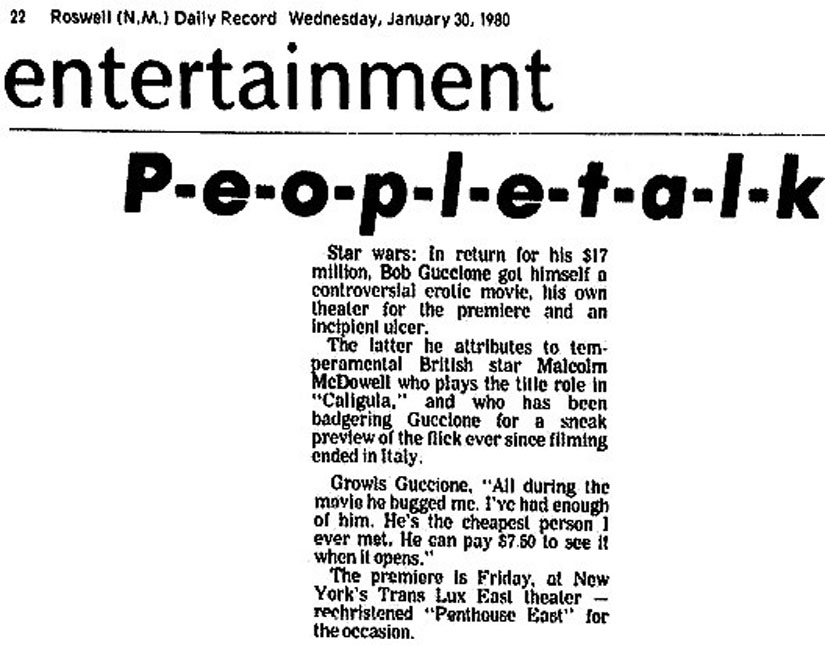
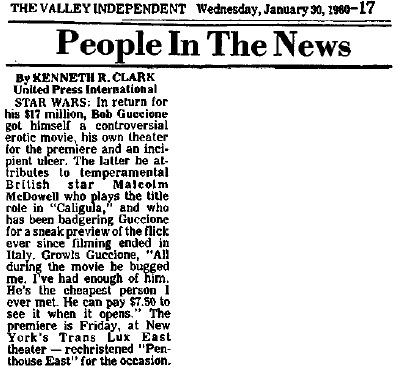
And paraphrased by Paul Sullivan:
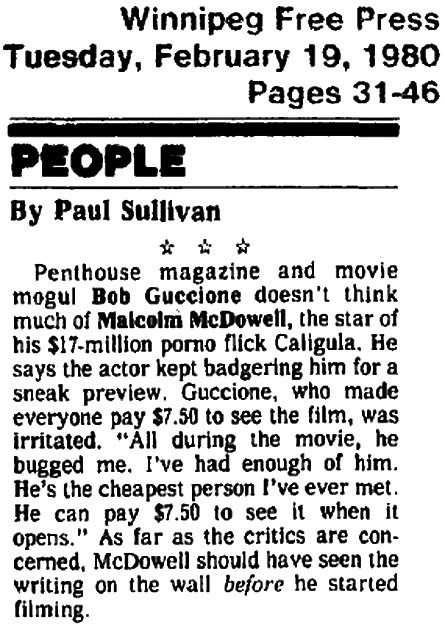
So... Malcolm had been clamoring to get a screening prior to release,
and Bob Guccione continued to refuse as late as late January 1980.
The UPI wire story above surely appeared on the
Teletype on Monday, 28 January 1980, for publication the following day,
which means that Guccione made his comments earlier on that Monday.
So now, with that background established, let’s look at some interviews given by Malcolm McDowell
over the following year or so:
|
Roderick Mann, “Heaving a Yellow Brick at Studio 54,” The Los Ángeles Times,
Thursday, 10 April 1980, sec 6 p 1:
|
|
Andrea Chambers, COUPLES: “Malcolm McDowell’s Romance with Mary Steenburgen Has Gone Just Like Clockwork,”
People magazine, 1 September 1980, p 66:
|
|
Sebastian Cody, “Oh, Caligula!” The Tatler, October 1980, p 80:
|
Roderick Mann, “Malcolm McDowell: Nervous as a Cat?” The Los Ángeles Times,
16 April 1981, p 11:
|
So far it looks like he’s exaggerating, to say the least,
because there are only about six minutes of hardcore in the movie,
and the editors in London never — NEVER! — included more than about six minutes of hardcore in any copy of the film,
no matter how rough or early or preliminary.
But when did he catch this “private showing”?
Certainly after about 28 January 1980, and, as we shall soon see, certainly before 7 April 1980.
There had been private trade screenings beginning in November 1978 (an unfinished print in London),
and then in Cannes (May 1979),
and here and there in the US (beginning in May 1979?).
So Malcolm saw a PRIVATE showing of the movie as early as the tail end of January, possibly in February,
possibly in March, or in the first few days of April at the very latest.
Would there have been private screenings between January and early April 1980?
Apparently so.
By January 1980 the film had already landed a distributor, Analysis Film Releasing Corporation,
and once that happened, exhibitors would want to take a look before booking the film for extended runs.
Further, international distributors would also want to take a look, and their deputies were stationed in and around Hollywood.
At least we now know from this quote a detail we never had before: McDowell’s agent, David Wardlow, accompanied him.
But then years later McDowell added a statement and changed his story, and with this the pieces begin to come together:
...The first time I saw it was at a sneak preview in Hollywood.
The people from Penthouse refused me admission.
But Guccione said, “Let him in.”
They had included two 20-minute segments of hard-core porn.
I now have some idea what it must feel like to be raped.
The second time around they had taken out the porn and it was much better.
|
What on earth does that mean?
There were no sneak previews.
Bob Guccione was adamant about never sneak-previewing the film
and about never permitting press screenings.
So as we surmised above, McDowell must have crashed a private trade screening
(for distributors, exhibitors, and select VIP’s).
The Penthouse people would certainly have been gatekeepers at all the trade screenings,
and they certainly would have wanted to keep a gate-crasher out.
Guccione would also have been at most or all of the trade screenings as well.
This begins to make some sense!
Now, how does one find out where this Hollywood screening took place?
It was a private event. There were no ads, no brochures, no publicly available announcements, nothing.
The most there would have been were a few interoffice memos and maybe some telephone calls — rather ephemeral evidence.
There is no mention of this event in Franco Rossellini’s files, probably because he never knew about it.
So how does one find out? One needs three ingredients for this recipe.
The first ingredient one needs is relentless tenacity.
The second ingredient one needs is even more important — as a matter of fact, it is the most important ingredient of all;
it is the single ingredient without which one can accomplish nothing in life:
a stroke of the most jaw-dropping luck coming from entirely out of the blue.
The third ingredient is much more important than the first ingredient, though slightly less important than the second:
knowing where to find a genius librarian.
Ingredient Number One is irremediably with me.
Ingredient Number Two stumbled into my lap in two phases, on 30 July and on 4 August 2014.
I shan’t breach that confidentiality.
Ingredient Number Three came along on the evening of Tuesday, 5 August 2014.
So, after years of wondering, I was at last able to discover where this private trade screening took place.
It was at the Preview House, 7655 W Sunset Blvd, Hollywood CA 90046.
The venue is for special events only, primarily private studio screenings.
It is not open to the public.
I have not been able to get the exact date of this screening,
but I have narrowed the time frame down to the last few days of March or the first three days of April 1980.
For the record, we should note that the Preview House opened in 1970, closed down from about 1996 through the first part of 1998,
and then reopened sometime in 1998 as the
Harmony Gold Preview House.
Now I need to find out who the projectionist was that day, hope that the person is still alive and well,
and discover where the log books are kept.
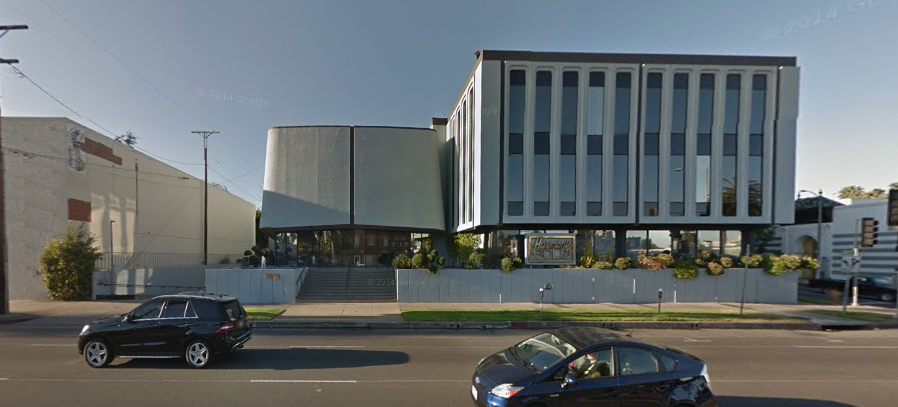
Exterior image grabbed from Google Maps.
This is five blocks east of Fairfax Avenue, between Courtney Avenue and Stanley Avenue.
The camera is facing north. The cars are heading west.
The staircase leads to the screening room’s entrance.
Now back to Malcolm’s story.
How did the “twenty minutes of porn” suddenly become “two 20-minute segments of hard-core porn”?
Simple.
Ten years had passed, and McDowell’s memory was acting up.
He remembered that there were two porn sequences, and he remembered something about twenty minutes.
He merely conflated the two memories.
Either that or he was misquoted.
Even more confusing is his statement that the “second time around they had taken out the porn and it was much better.”
What was this second time around?
Was he talking about the R-rated version?
No, he was not.
If we leaf back through ten years of dusty pages, we find yet another statement he made, which helps put things into perspective:
Now at last we can begin to understand.
He had gate-crashed a private trade screening in the last few days of March or in the first few days of April 1980 in Hollywood,
but he could not possibly have “anted up at the boxoffice” when he saw it that day,
because the Preview House, a private venue never open to the public, did not have a boxoffice.
So what was this about anting up at the boxoffice to purchase a ticket?
He “anted up at the boxoffice” when he went to see a public screening the “second time around,”
and the “second time around,” as we can see from the date of the article,
was in the first part of 1980, prior to 7 April 1980, most likely on Saturday or Sunday, 5 or 6 April.
(The UPI story unquestionably came through on the Teletype on 6 April 1980 for publication the next day.)
That’s when “they had taken out the porn and it was much better,”
though still not at all good, if we are to judge from his other statements.
Clearly, of course, they had NOT “taken out the porn”; they had taken out MOST of the porn.
But Malcolm was simplifying for the press or, again, he was misquoted by a journalist whose shorthand left something to be desired.
Where did he ant up at the boxoffice? Certainly not in or anywhere near Hollywood.
Caligula had not yet opened in Hollywood by 7 April 1980.
Its first public screening in Hollywood was on 18 April 1980
at the Holly Theatre.
So that means that there were only three cinemas anywhere in the world
where McDowell could have seen a public screening of the movie:
The Penthouse East in Manhattan NY,
the Lumiere in San Francisco CA,
or the Georgetown in Washington DC.
He and Mary Steenburgen were living in an apartment in NYC in the spring of 1980
because he was trying out for stage parts, and as we can see from the above UPI story,
his best bet was off-Broadway in Look Back in Anger, which is indeed the part he was hired for.
(Previews began Friday, 6 June 1980, the show opened Thursday, 19 June 1980, and it ran through Sunday, 12 October 1980).
So he probably saw the movie at the Penthouse East, though that is by no means certain.
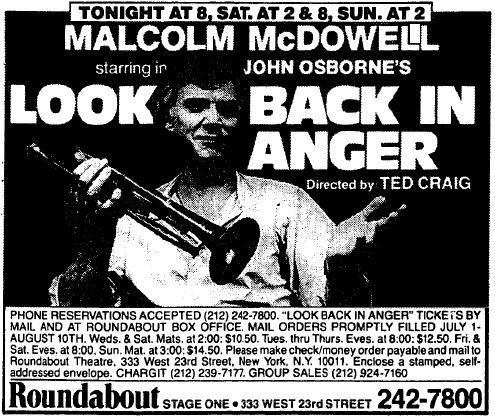

So let’s summarize:
• |
28 January 1980: Malcolm McDowell is still demanding a pre-release screening,
and Bob Guccione is refusing. |
• |
Sometime in the last few days of March or the first three days of April 1980:
Malcolm McDowell and his agent David Wardlow
gatecrash a trade screening of a padded print in Hollywood.
|
• |
Circa 5 April 1980: Malcolm McDowell stands in line to purchase a ticket
to the standard 156-minute version,
probably at the Penthouse East in Manhattan.
|
|
SIDEBAR: Like Vidal, like Brass, like others,
McDowell occasionally changed his story,
most likely under the advisement of legal counsel.
In 1995 he denied having seen the film when it was new.
Here is what he said to John Naughton for “O Lucky Man?,” in the UK edition of
Premiere: The Movie Magazine 3 no 2,
March 1995, p 60:
“...I found it to be an extraordinary betrayal.
It took me many years to get over it.
In fact it was years and years before I even saw the movie.”
A few years earlier he said something else equally intriguing.
Mike Bygrave, “Life without Alex,” The Guardian, 23 March 1989, p 29:
“I was at a dinner party in Hollywood sitting next to a very distinguished screenwriter [Wolfgang Petersen?]
who told me I’d been in one of his favourite films.
I thought ‘Oh, if.... or Clockwork Orange,
maybe O Lucky Man! — the usual.’
But he meant Caligula.
He talked to me about it all night, so I went out and rented a video.
It’s not as bad as I thought. In fact, it could have been a great film.
But, for all Guccione’s horrible editing and the porno sequences he put in,
it actually remains an interesting failure.”
That’s not enough for you, is it? You want more, yes?
Here is what Malcolm McDowell said to Glenn O’Brien in “A Man or God of the Moment: Caligula,”
AnOtherMan no 2 (Spring/Summer 2006), p 178:
“I once sat with the producer of Das Boot [Günter Rohrbach?] and he said,
‘Malcolm you were in my favourite movie of all time,’ and I said,
‘Thank you very much,’ expecting him to mean Clockwork Orange,
and he said, ‘Caligula was the best film I’ve ever
seen.’ ”
|
If that reconstruction of events is correct,
and I don’t see any way around it,
that means that Guccione, who was licensing a cinema and who could therefore have
shown anything he pleased, chose to run the 156-minute final cut,
while he was still attempting to entice domestic exhibitors and international distributors
with a padded edition.
No, that doesn’t make any sense at all.
But then, nothing about Caligula makes any sense.
We need to wonder about something else too.
McDowell saw a private trade screening and was horrified by it.
Why then, shortly afterwards, would he stand in line and purchase a ticket for a public screening?
I had long thought that a possible reason is that at the trade screening
some Penthouse representative explained to the exhibitors and distributors in attendance
that what they were about to see was a version somewhat different,
somewhat stronger than the one currently being shown to the public.
Admittedly, that was just my guess, but it was an educated guess and a reasonable one.
That’s precisely the sort of introduction that would induce McDowell
to see for himself precisely what those differences were.
And yet, I admit, I have discovered that no such thing happened.
Nobody at that screening said a syllable about the trade print being any different from the release print.
The most likely possibility, of course, is much more prosaic and much more believable:
Malcolm may simply have noted that critics wrote about the “six minutes” of porn rather than twenty,
and he may have noted that the running time as listed in the reviews was shorter as well.
He was more than intelligent enough to suspect that the trade print he had seen was spiked,
and he was right to check it against the release version.
Let’s do some arithmetic.
The usual 156-minute version has about six minutes of porn.
If McDowell saw 20 minutes, and if the print was like the usual one in every other way, then it ran about 170 minutes.
If McDowell’s claim is, in essence, correct, then in the first part of 1980 there was a trade-show print
with an extra 14 minutes or so possibly of the lesbian tryst and certainly of the Imperial Brothel.
That would mean that after editing had been completed, and after the final 156-minute version settled upon,
Guccione would have hired a fly-by-night editor to fly by night to Joinville-le-Pont to run off a padded print with extra materials.
Since the dialogue and music and effects tracks had never been recorded for a padded version,
in all likelihood the soundtrack was artifically lengthened for the extended sequences.
That would not have been at all difficult.
The lesbian tryst had no sound to speak of, and
the ominous music could easily have been extended by repeating passages.
As for the Imperial Brothel,
it would have been easy to re-edit the percussion music and extend it 10 minutes
or 15 minutes or even more, without the audio splices being noticeable.
Actually, the Imperial Brothel scene was greatly padded even in the 156-minute version.
It should have run no more than three or four minutes,
but the needless additions stretched it out to 11 minutes.
To accomplish further padding, Malcolm’s ten-in-one carnival-talker routine
(“Only five gold pieces!”)
could have been extended by what would now be called sampling,
and such sampling could have been continued ad infinitum.
This would not have been a challenge for a competent sound editor,
for at that time all the master tapes were still on file
and could without difficulty have been re-edited and remixed.
Now, I’m trying to think this through.
If there was a padded print,
then it was most likely physically hot-spliced together from two different sources.
I say that because to make a finished print would require printing it
from a finished negative or internegative or CRI.
Surely the negative was not tampered with again.
That limits the possibilities: a new internegative or a new CRI
was created with the extra material inserted probably courtesy of A-B rolls.
Yet it is not cost-effective to create such a new internegative or CRI for a single trade print
that might never be released.
The most cost-effective thing to do would be to run off rolls of the extra material
with markings for where they should be spliced in.
To make the extra material even more cost-effective, the best thing to do
would be to have only a single piece — or two single pieces — to cut in.
And that, indeed, is what I suspect happened.
To understand the argument, you need to realize that at the editing facilities Caligula
was assembled onto sixteen 1,000' reels, numbered 1A, 1B, 2A, 2B, 3A, 3B, 4A, 4B, 5A, 5B, 6A, 6B, 7A, 7B, 8A, 8B.
These sixteen reels were in turn printed onto eight 2,000' rolls of film.
The beginning of Reel 1 was labeled “1A” and the end of Reel 1 was labeled “1B.”
The beginning of Reel 2 was labeled “2A” and the end of Reel 2 was labeled “2B.”
That pattern continued all the way through Reel 8 being labeled as Reel 8A and Reel 8B.
SIDEBAR — This is only for those who really enjoy movie history.
If that doesn’t apply to you, skip over it.
To understand the changing conventions of reel numbering
you need to know not the way things are done now, and not the way they’ve been done over the past few decades.
You need a brief history lesson.
Movies were shipped basically two different ways.
Sometimes films arrived in crates that contained cans, in each of which was a roll of film wound onto a core.
More often, though, films arrived in dented shipping cases, almost always octagonal (rarely square),
crammed far too tightly with cheap warped shipping reels with sharp burrs.
In the old days the reels (whether wound onto cores or mounted onto shipping reels)
were a little over 1,000' long at most.
By the 1910’s it became practice for cinemas to splice two 1,000' reels onto a single 2,000' reel.
By the mid-1910’s the typical projection booth had two or more projectors.
Reels had onscreen cues, and when a reel was coming to an end
the projectionist merely had to follow the cues to know when to kill the old reel and go live with the new one.
If done properly the change-over was seamless.
(In the silent days the cues consisted of onscreen title cards:
“End of Part One” “Part Two” “End of Part Two” and so forth —
except at MGM, which had a different method.
Beginning in 1930 studios began to drop the old “Part Title” system
in favor of serrated circles in the upper-right corner of the screen.
By 1936 that new cue system was universal.
Because automation and
platters had long been ubiquitous,
visible cues were finally dropped in the past decade or so.)
I think it was by the early 1940’s that it became common practice
for distributors to dispatch films prepared for such combining,
though projectionists, of course, were still expected to disassemble the combined reels
before sending the movies back.
I think it was later in the 1940’s that it became common practice
for the distributors and/or exchanges themselves
to combine the 1,000' reels onto 2,000' reels.
That’s when the numbering system began to change.
Instead of Reels 1, 2, 3, 4, 5, 6, and so forth, there would be Reels 1A, 1B, 2A, 2B, 3A, 3B, and so forth.
Until the mid-1970’s there was thus a noticeable hot splice in the middle of every 2,000' reel that a cinema received.
(There was also frequently the phenomenon of the sound from the old reel continuing a moment into the beginning of the new reel,
since sound and picture are separated by 21 frames.
For films in which picture and sound began and ended at the exact same moment,
with sound printed on the 21 frames of leader immediately preceding the image
and with the sound stripe going blank for the final 21 frames of film,
there would be a moment of silence at each reel join, sometimes resulting in the loss of dialogue.
Very annoying.)
Then in the mid-1970’s there was a new practice, as rolls of film began to be manufactured in 2,000' lengths.
But because editing facilities still operated on a 1,000'-reel basis,
for some years after it still remained common practice
to have a 2,000' reel be labeled, for instance, “1A” at the beginning and “1B” at the end.
Younger projectionists couldn’t understand why and so I had to explain, not that they ever cared enough to remember what I said.
Now that you’ve digested that, you can understand that the final edited Caligula was
eight 2,000' reels, with each reel having an A at the beginning and a B at the end.
That is how the reels are numbered in the cutting continuity,
though that may well have been altered by the time the labs made prints for sending out to cinemas.
|
We need to learn now about Caligula’s musical history.
Tinto Brass had commissioned Fiorenzo Carpi to do the music.
Carpi wrote up some skeletal drafts of what were later to have become orchestrated compositions;
they were simply beats rather than tunes.
We can hear brief moments of some of those drafts played in the background of Giancarlo Lui’s
making-of promotional film,
specifically during the Sacred Dance of Isis and during Cæsonia’s dance.
Carpi planned to complete his compositions only after Tinto had completed editing the film,
but as we know, that never happened.
Once Tinto was gone, so was Fiorenzo.
Why? Jack Silverman fired him.
Why? He didn’t say so explicitly, but when we read between the lines,
it is obvious that he believed the skeletal drafts were indeed the final compositions,
and that’s why he decided that such a hack composer just had to go.
So that was the end of Fiorenzo’s involvement.
So typical.
Silverman was convinced that, because he was respected for making advertising deals for newspapers and magazines,
he was smarter than everyone else.
He assumed that he knew more than writers, directors, composers, technicians.
That is precisely why he routinely fired his best people:
He had no idea what their work required, and when he saw something in progress, in an unfinished state, he assumed it would never get any better.
So a boot out the door, e il problema è risolto.
It is Silverman, more than anyone else, who is responsible for converting Caligula from an interesting film into a dreadful film,
simply because he fired the only qualified personnel.
He replaced them with fine people, but the fine replacements came into the project cold, with no background on who had done what or why.
The people who had to serve under him were absolutely exasperated by his idiocy.
He, in turn, thought they were immature crybabies who childishly resented his achievements.
Here is a Silverman story.
It comes from the largely fictional Ultimate Porno: The Making of a Sex Colossal (NY: Eyecontact, 1981, pp. 267–269),
penned by assistant director Piernico Solinas.
I have been able to verify several passages in this book,
and I have been able to disprove many other passages.
This is one of the passages that seems to have the ring of truth:
|
“Action!” The wave reached the end of the nave and the
street sprang to life. A few seconds later, Caligula appeared on the
threshold of the huge portal down there somewhere. In a
few more seconds, Jack Silverman appeared on the threshold
of a portal considerably closer to us, maybe a hundred meters
away. Jaws [Silverman] was dressed in British tweed. Jaws walked out of
the portal and into the street.
Oh, Jaws!
Tinto had his eye to the hole, running the zoom himself. He
must have still been tight on Malcolm because he hadn’t
reacted to Jaws yet —
Jaws kept walking, like a robot, a fixed gaze on his face.
Extras who saw him stopped performing. Of course.
To them, if people are strolling into the scene in street clothes, then this
wasn’t even a run-through.
Tinto’s finger began to move the stick on the zoom, opening
it up slowly as Malcolm walked down the nave.
Jaws kept walking. He was practically in the middle of
the street —
Finally I found the draw: Jaws was homing in on one of the
black dancers, or to be more accurate, on the gigantic cock on
one of the black dancers which, as he swayed, swung as slowly
and relentlessly as a pendulum.
Tinto’s finger on the zoom stick stopped. He looked up from
the camera. His face was all eyes. It’d taken hours to get this
take ready and here was some idiot walking right in front of the
camera? Thanks to Jaws, it could take hours to get it ready
again. I wouldn’t like to have been in Jaws’s shoes right now.
Tinto quit the camera, grabbed a bullhorn, and explained to
Jaws what he’d done. Tinto was straining to remain civilized.
Amazingly, Jaws didn’t apologize. Maybe he thought because
he ate in the VIP restaurant he didn’t have to. Or maybe he was
just so inexperienced he didn’t even realize what he’d done.
Cazzo, Jaws, either way you’re really asking for it.
The whole nave was quiet, all eyes on Tinto as he strode
toward Jaws. Tinto looked mad enough to deliver a lethal blow
to Jaws’s shark nose. More than a few of us experienced a
strange mixture of tension and pleasure at the prospect of Tinto
sending Jaws somersaulting through the air like a dolphin at
Marineland.
Tinto stood in front of Jaws.
Would he hit him?
Tinto contracted his face muscles until his head was a huge
fist, his whole body quaked, he snarled, he swung his arm into
the air, raised the bullhorn and — oh, no — smashed it into the
ground in front of Jaws’s feet.
“You make your own film, Mister Silverman,” he
screamed, then stomped off into his trailer.
We all rushed to the poor bullhorn to see if it had been
hurt.
Franco Rossellini, who’d been taking a sexual census of the
crew with Madame [Roberto] Tatti to find out who was gay, hurried over
twirling his gold umbrella and flying his snappy Burberry.
There was only one thing to do, Franco explained to Jaws.
Apologize.
Did he have to?
He had to.
So Jack reluctantly entered Tinto’s trailer.
The trailer bounced on its wheels.
Half an hour later, the door of the trailer opened. The Big
Bear stepped out, followed by the Limp Shark. So much for
going home early.
|
A few years later, once Nino Baragli completed his rough cut,
Franco Rossellini hired his preferred composer, Franco Mannino,
to write a score in a matter of weeks, and Mannino miraculously complied.
Penthouse flatly rejected this score immediately upon hearing it,
and decided instead to assemble and commission an entirely new score.
Penthouse was delighted to be informed by legal counsel that
Prokofiev’s ballet music and Khachaturian’s “Spartacus” were public domain in the US.
These pieces, you see, had been created and premièred prior to the copyright agreement between the USSR and the US.
Penthouse was less than delighted to receive summonses in the mail, for the pieces had actually been copyrighted in France.
Soviet composers, apparently, knew how to protect their works!
That matter was quickly resolved with significant money settlements.
Felix, meanwhile, licensed the rights from G. Ricordi & C., SpA, for showings in Italy.
Penthouse licensed library music composed by Arvay and Snell, though it ultimately dumped the Snell piece
(“The Millpond,” side 2 track 3 from
The Early Birds — Small Group Sounds,
Chappell International Series, Chappell Recorded Music Library — CAL 4007, released in 1974).
Then Penthouse hired a certain “Paul Clemente” to compose the remainder of the incidental score.
As you all know by now, “Paul Clemente” was Bruno Nicolai’s new pseudonym.
In the past he had once called himself Leo Flag; this time around he was Paul Clemente. So it goes.
Nicolai submitted some of his pre-existing music,
some of which was copyrighted by Edi-Pan Edizioni Musicali and some of which was copyrighted by Edizioni Musicali Gemelli Srl.
Somehow Gemelli was authorized to sell utilization rights to those particular Edi-Pan pieces.
Nicolai also composed new pieces specifically for Caligula,
which he had copyrighted through Edizioni Musicali Gemelli, Srl,
which was owned by a certain Alberto Nicolai
(“gemelli” is Latin for “twins,” and so I presume they were twin brothers, but I don’t know for certain).
Edi-Pan Edizioni Musicali also owned the rights to an interesting piece of music by John Leach called “Spartan War,”
of which Gemelli had authority to license an excerpt (for the Papyrus Cane scene).
So now that you’ve got that information under your belt, you’re prepared to continue the investigation.
I strongly doubt that the lesbian scene was lengthened.
It would have been easy to pad out the sound, but the image presented a problem.
The sequence began a little bit into Reel 5A and would not have been easy to expand without recutting the camera negative.
Yes, it could have been done, but only with difficulty.
I suspect, though, that the Imperial Bordello was padded by a single 14-minute stretch.
So let’s first remind ourselves about the Imperial Bordello as it was supposed to be in the original film.
Caligula calls Longinus to his private suite to propose that he raise funds for war
by establishing an Imperial Bordello.
He then leads Longinus and the rest of the retinue
through a draped doorway and directly into the Imperial Bordello!
The boat-shaped Imperial Bordello, you see, was built into Caligula’s private dining room.
All is dead silence, and everyone in the Imperial Bordello is frozen in midmotion, still as a statue.
Caligula, Cæsonia, and the Little Giant climb aboard, Caligula shouts out “Action!”
and then suddenly everyone bursts into life.
For the final edit of the movie, that’s not what happens, for footage was scrambled and deleted,
and the sound was recorded entirely differently.
In the final edit, Caligula proposes establishing an Imperial Bordello and then walks away.
There is a jump cut as we see Caligula burst through a draped doorway,
and this is accompanied by the sound of a loud gong that takes forever to diminish.
It is the jump cut combined with the sound of the gong that makes it seem we have skipped ahead to a new scene,
though in reality are just continuing in the same scene.
By mixing the shot sequence up, everyone is already making whoopee as Caligula, Cæsonia, and the Little Giant climb aboard,
with Caligula already loudly hawking his wares.
The remainder of the scene consists of fragments of shots that are almost entirely out of sequence,
intercut with numerous shots of hardcore porn done in a completely different style.
I decided to check the cutting continuity to learn precisely where the Imperial Bordello begins and ends.
That’s when I learned that it begins 8 minutes (706') into Reel 7A and continues through the bulk of Reel 7B.
A ha! So Reel 7 is the prime suspect in this case.
This called for further examination.
The total length of Reel 7(A&B) is nearly 20 minutes (1,764'9fr).
Reel 7A is nearly 11 minutes (948'), ending with Valerie Rae Clark servicing a midget,
and Reel 7B is just over 9 minutes (816'9fr),
beginning with Anneka di Lorenzo laughing just before Caligula says, off-screen,
“Enjoy the rights of those who govern you! Take their wives! Use them! Confuse them!”
(Or does he really say “Use them! Abuse them!”? Hard to tell.
Half the times I listen to this I clearly, unmistakably hear Malcolm say “Confuse,”
but the other half the times I listen to this, I clearly, unmistakably hear Malcolm say “Abuse.”
Now that I listen to it some more, it sounds like Malcolm misspoke and said “Combuse.”)
That was most intriguing, because that brought something back to mind.
The first time I saw the movie was at the 4 October 1980 matinée in Albuquerque.
The projectionist had to sneak me in because management wanted me dead —
that’s how I came to be one of the rare people who got to see the movie for free in its first run.
At that screening I noticed something strange at that particular moment in the movie, right between those two shots.
And I’ve noticed that same strange thing every time I’ve watched the movie since,
but I never thought it significant and so I paid it no real attention.
Now that I have obsessed on the above hypothesis, though,
I can see clearly that what I noticed is significant after all!
You see, I distinctly remembered a jump in the music between those two shots.
So I plopped in the DVD to check, and of course! My memory was correct!
The music at the end of Reel 7A abruptly cuts off two beats into a 4/4 measure,
and the music in Reel 7B starts all over again at the beginning of a different movement of that same piece.
The cut would be bothersomely noticeable except that it is masked
by the sound of a gong that takes forever to diminish.
That is the same gong sound that was used a few minutes earlier
to make Caligula’s entrance seem like the beginning of a new scene.
When we listen to both instances of the gong, we can hear that it was not part of Bruno Nicolai’s score,
but was added by the sound-effects department.
In both instances the gong covers a gap.
So now there is no question about it.
There is definitely something missing between Reel 7A and Reel 7B.
The extra 14 minutes must have come right between those two moments.
Thus Reel 7(A&B) would have been expanded to become two reels consisting of
7A, 7A.1, 7A.2, and 7B.
With that assembly, 7A and 7A.1 would be spliced together to make a new Reel 7,
and 7A.2 and 7B would be spliced together to make a new Reel 8.
The original Reel 8(A&B) would have been renumbered Reel 9(A&B).
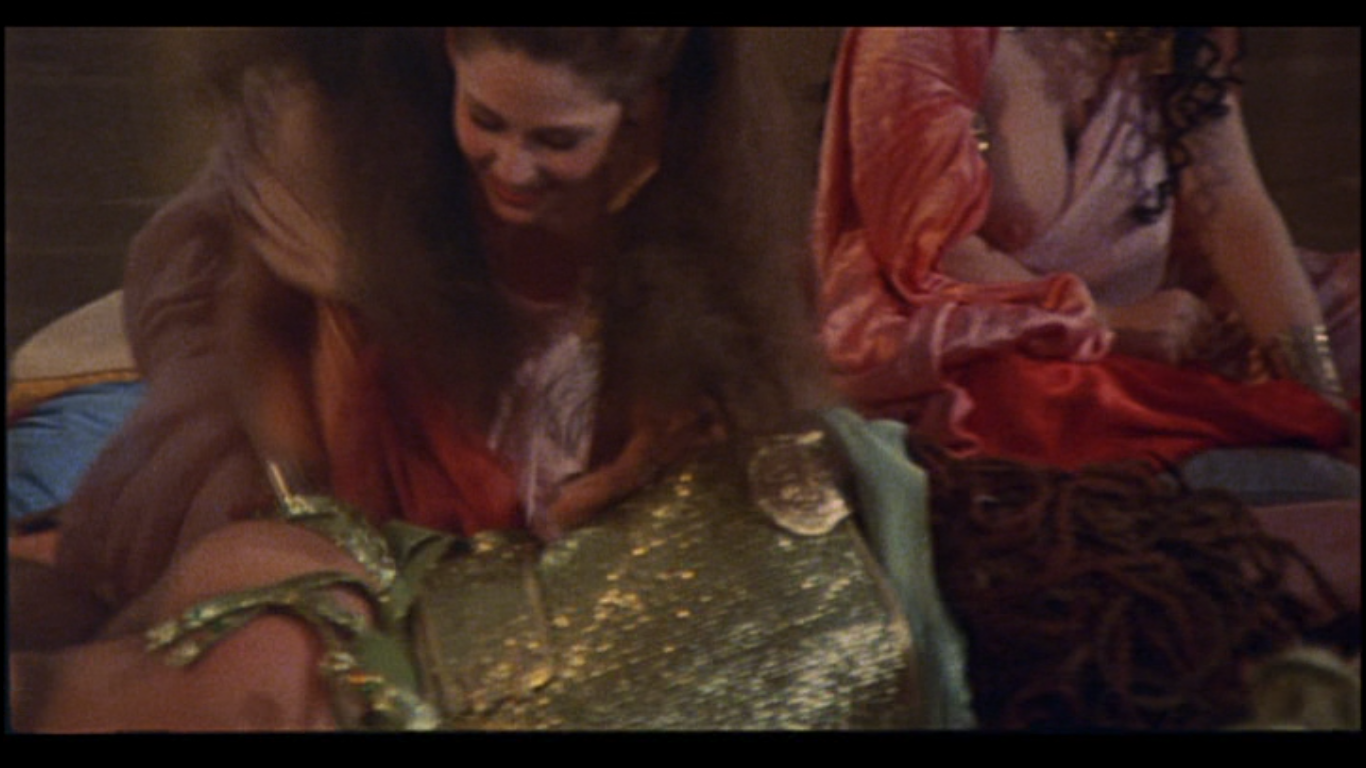
Reel 7A, Japanese Imperial Edition, Disc 1, 2:09:21
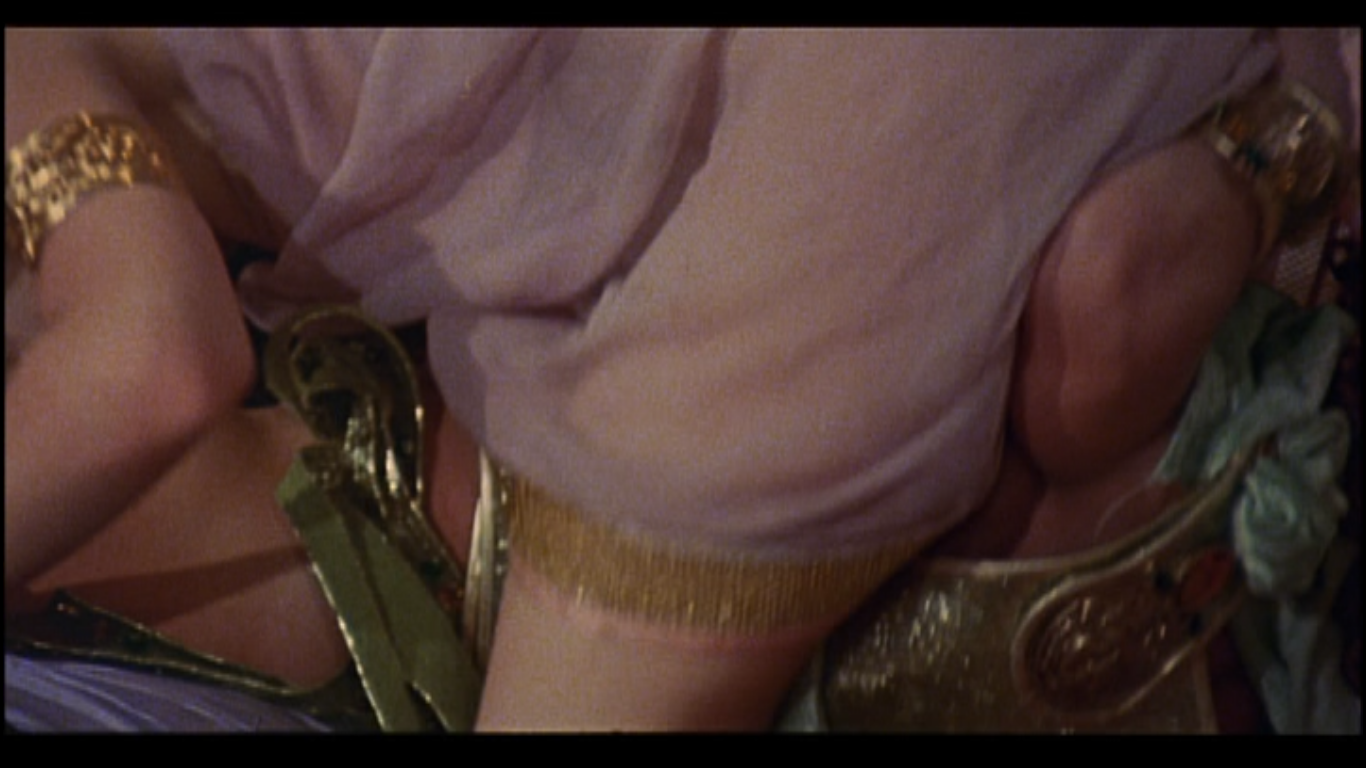
Reel 7A, Japanese Imperial Edition, Disc 1, 2:09:31
This is the end of Reel 7A. The music comes to an abrupt end in mid-measure.
The camera negative here would have a lab splice leading into...

Reel 7B, Japanese Imperial Edition, Disc 1, 2:09:31
A different movement of that same piece of music
that was suddenly chopped off now begins, from the top.
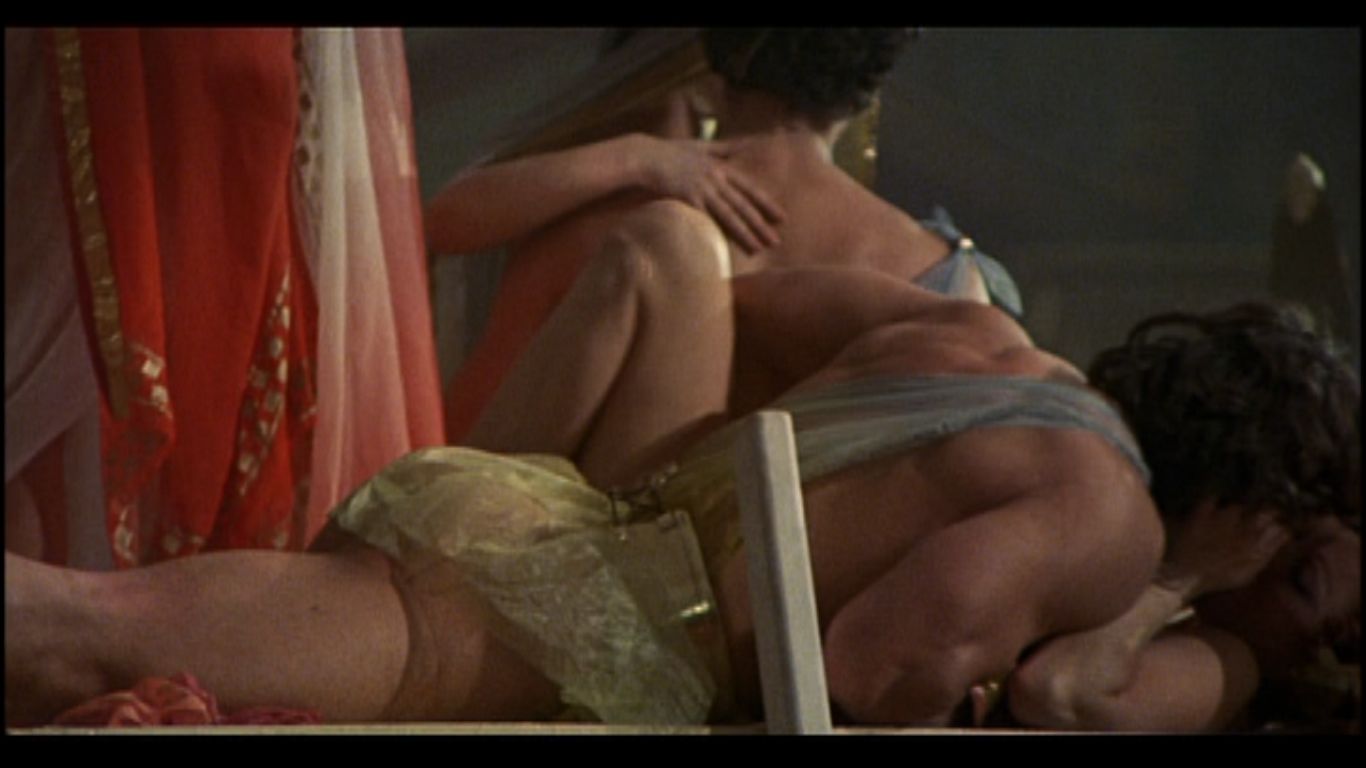
Reel 7B, Japanese Imperial Edition, Disc 1, 2:09:37
Now, of course, that would seem to destroy my previous theory that the extra material was added later,
but, in fact, it strengthens it.
Nicolai composed his score to synchronize with Baragli’s cut of the scene.
If material had been added later, then there would be a noticeable break in the sound
only if the extra footage were spliced in.
Instead, though, the discontinuity occurs in the standard Baragli version as polished by the Twickenham crew.
That means that something happened during the mixing sessions at GTC-CTM.
When the members of the GTC-CTM sound crew mixed the music,
they re-edited the music to synchronize it with a version longer than the one edited at Twickenham!
And after they thus mixed it, they crudely chopped the extra 14 minutes out again to match the scenes and reel breaks
as finalized at Twickenham, thus causing a distinct break in the music!
And speaking of music...
...Take note of something else.
One of Caligula’s statements was edited into incomprehensibility:
“And for only five gold pieces to any one of you!”
We’ll never know what the original line was, because it was never in the looping script;
Malcolm McDowell ad-libbed it during post-sync.
That is a clue that leads us to notice a similar problem, for there are other strange anomalies in the sound editing during this scene.
Pay attention to
the musical accompaniment during this scene.
Passages repeat, and the music occasionally fades out and then back in again.
At first I thought the volume was faded down to make way for the actors’ lines,
but that’s not the case at all!
The volume was faded down to facilitate splices to make repeats where the original recording did not have repeats.
At a low volume, underneath all the other noise, the cuts are unnoticeable.
Instruments that were separately miked were mixed back in differently so that repeated passages would sound new,
generally courtesy of overlays and cross-fades.
Oddly, there are a few moments of Franco Mannino’s earlier rejected attempt at a score for this scene.
On regular speakers it’s nearly impossible to distinguish the brief overlays from the underlying score.
So listen here to Mannino’s earlier version:
Mannino’s cue M.21.
Sorry. I don’t have the entire piece of music, only the beginning. The tape cuts off after a few minutes.
But you get the idea anyway. And it’s interesting, yes?
Now put on your headphones or earbuds, and listen once again to the music as it appears in the final film.
Pay especial attention to 4:25, 4:43, 4:59, and 6:13.
The Mannino clips are tampered with, as only a few tracks of the original multitrack recordings were used,
and they are overlaid with great precision over Nicolai’s version, with the beats perfectly synchronizing.
Those overlays are only a few measures long each, else the sync would have been lost.
Clearly Nicolai’s music was re-edited
better to match the editing crew’s post-Baragli polish of this scene.
When the new editing crew at GTC-CTM expanded the scene,
they tampered with the music again,
and when they recut the scene to match what the Twickenham crew had done,
they did not revert to the earlier mix, but simply chopped the padded music up.
It was — and remains — impossible to know precisely what those changes were,
and in part that’s because we are not permitted to listen to the original unaltered recording.
That is what we so hoped to do, at long last, except...
...It was Friday, 14 November 1980 (I’m pretty sure that was the day,
though my memory is admittedly a little bit foggy after lo these many years).
We all eagerly leapt out of bed that morning to dash out to the nearest record shop and grab the gatefold OST LP.
To heck with school. To heck with work.
This was a big day and we were going to stay at home listening to tunes.
Nothing else mattered. Who could ever forget that day?
We paid for the album, hopped onto the bus, ran the several blocks back home,
and then with bated breath we excitedly dropped the needle onto our lovely new purchase.
But... what... happened? Something was wrong.
Where was that beautiful
medieval-sounding
piece that accompanied Mnester’s Pyramid of Power and its momentary
Coda?
Where was that aforementioned hilarious
rhythmic percussion piece that accompanied the Imperial Brothel?
Where did they go?
Those pieces constituted the main reason we all played hooky that day.
We felt cheated. And therein lies another story.
For, you see, I am convinced that we have all had a missing piece of the movie
on our shelves at home for upwards of 30 years — and that we never noticed.
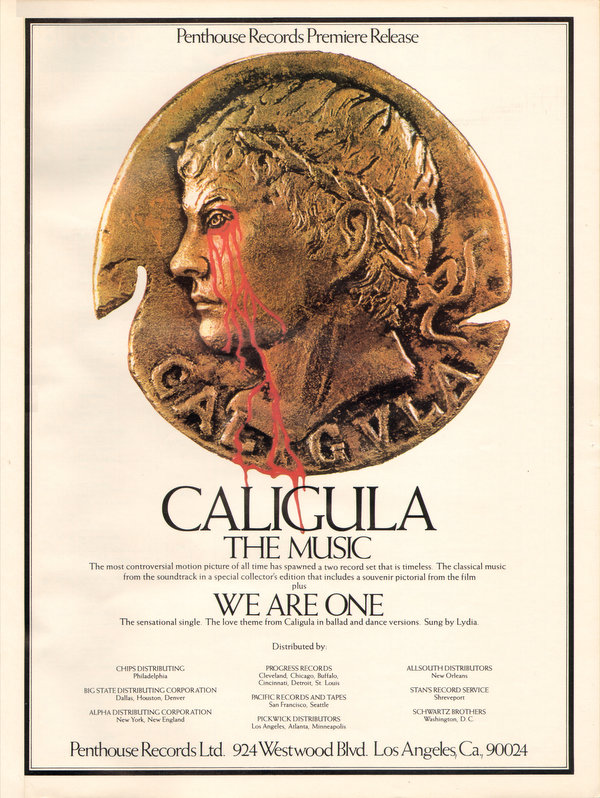
Billboard 92 no 47, 22 November 1980, p. 81.
Note that the coin is lopsided, and that the blood is not dripping straight down,
but is descending at an angle.
So here’s the story.
By now you should know that, despite all the hype, the producer of Caligula was Franco Rossellini of Felix Cinematografica, Srl, of Rome.
It was Felix that had originated the project, obtained the rights, gotten the government licenses, owned the copyright,
did most of the hiring, performed the logistics, and raised three-quarters of the funds.
Penthouse Films International, Ltd., of Manhattan arranged some additional sources of funding
through offshore bank accounts and offered collateral to Italian investors.
In return, Felix granted Penthouse almost total artistic control,
gave Penthouse presenter credit, and granted Guccione a coproducer credit
(which, by the way, effectively made Guccione an employee of Felix, not the other way around).
Felix also agreed, verbally, to keep out of the limelight and let Penthouse have all the namebrand PR.
(Penthouse’s execs, including Jack Silverman and Giancarlo Lui and even Penthouse’s UK attorney Ben Baker,
had been force-fed the information that Penthouse supplied ALL the monies, and that Franco Rossellini was merely line producer,
which is to say, in a nutshell, just a supervisor on Penthouse’s payroll.
And they believed that claim. And they were wrong, because the claim was totally bogus.
But everybody believed that claim, and it got reported far and wide. And it was totally bogus.
And the truth got reported nowhere at all. Nowhere. Nowhere. Ever.)
Since it was Penthouse and only Penthouse that had commissioned Nicolai to do a new score,
it was Penthouse’s and only Penthouse’s obligation to secure the rights to said music
as well as to Leach’s piece. Penthouse neglected to do so, thus putting the film and Felix in danger of lawsuits and worse.
It’s actually rather amazing that the film wasn’t impounded for this breach of contract.
When Felix made this discovery more than a year later, it immediately set about rescuing the situation.
On 8 September 1980 Felix Cinematografica obtained synchronous and nonsynchronous utilization rights
to 22 pieces of music from Edizioni Musicali Gemelli.
(Synchronous rights are the rights to use the music synchronized to a moving image.
Nonsynchronous rights are the rights to use the music anywhere else, generally in Original Soundtrack albums.)
As for utilization rights, you probably think that means copyright.
Wrong. Edizioni Musicali Gemelli retained the copyrights.
Felix had simply licensed the right to utilize Gemelli’s music in the film.
That is all. That was overinterpreted in court, and misinterpreted, too.
Peculiarly, it seems that some of the rejected pre-existing cues were included.
Inexplicably, it also seems that not all the Caligula cues were covered by the license!
Or am I wrong about that?
If you can match any of the pre-recorded pieces (at the top of the list)
with any of the cues, please write to me. Thanks!
The full list of the cues follows, and the pieces that Felix licensed are highlighted in bold.
|

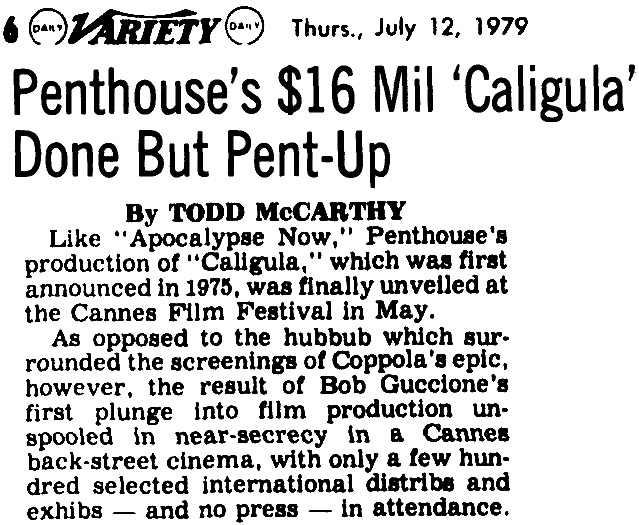

 Well, to put it mildly, I was flabbergasted!
If this report is true, then the print must have been made by some employee
of the lab that had performed the negative cutting and was currently holding that edited negative.
But what lab was that? According to all my research, that lab was, I thought,
Well, to put it mildly, I was flabbergasted!
If this report is true, then the print must have been made by some employee
of the lab that had performed the negative cutting and was currently holding that edited negative.
But what lab was that? According to all my research, that lab was, I thought,

